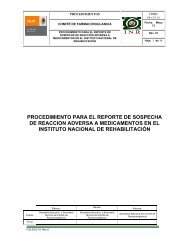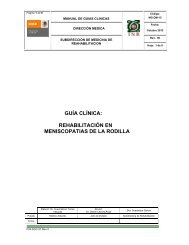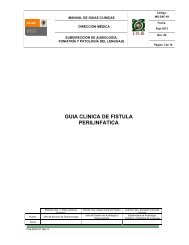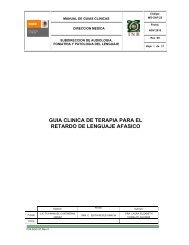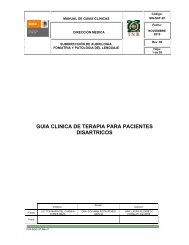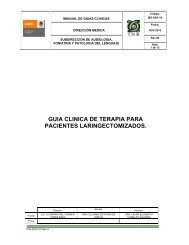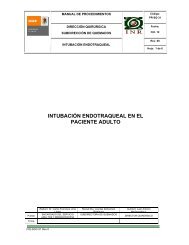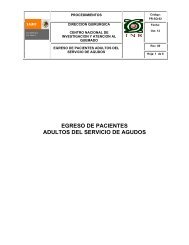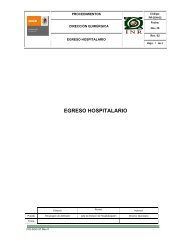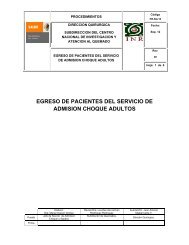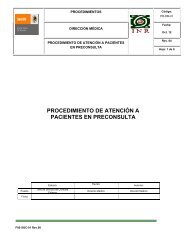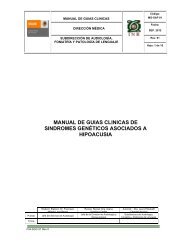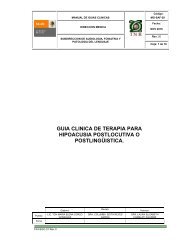manual de operaciones de procedimientos específicos de la clínica ...
manual de operaciones de procedimientos específicos de la clínica ...
manual de operaciones de procedimientos específicos de la clínica ...
You also want an ePaper? Increase the reach of your titles
YUMPU automatically turns print PDFs into web optimized ePapers that Google loves.
MANUAL DE OPERACIONES Código:<br />
MOP-DQ-01<br />
DIRECCIÓN QUIRÚRGICA<br />
PROCEDIMIENTOS ESPECÍFICOS DE LA<br />
CLÍNICA DE CATÉTERES<br />
E<strong>la</strong>boró: Autorizó:<br />
Puesto Personal <strong>de</strong> <strong>la</strong> Clínica <strong>de</strong> Catéteres Director Quirúrgico<br />
Firma<br />
F04-SGC-01 Rev.0<br />
MANUAL DE OPERACIONES DE<br />
Fecha: Mayo<br />
2012<br />
Rev. 00<br />
Hoja: 1 <strong>de</strong> 45<br />
PROCEDIMIENTOS ESPECÍFICOS DE LA CLÍNICA<br />
DE CATÉTERES
Introducción.<br />
1. Propósito.<br />
2. Alcance.<br />
3. Responsabilida<strong>de</strong>s.<br />
4. Políticas.<br />
5. Procedimientos:<br />
F04-SGC-01 Rev.0<br />
MANUAL DE OPERACIONES Código:<br />
MOP-DQ-01<br />
DIRECCIÓN QUIRÚRGICA<br />
PROCEDIMIENTOS ESPECÍFICOS DE LA<br />
CLÍNICA DE CATÉTERES<br />
ÍNDICE<br />
5.1 Colocación <strong>de</strong> catéter venoso central.<br />
5.2 Curación <strong>de</strong> catéter venoso central.<br />
5.3 Toma <strong>de</strong> muestras sanguíneas <strong>de</strong> catéter venoso central.<br />
5.4 Toma <strong>de</strong> hemocultivo <strong>de</strong> catéter venoso central.<br />
5.5 Retiro <strong>de</strong> catéter venoso central.<br />
5.6 Cultivo <strong>de</strong> punta <strong>de</strong> catéter venoso central.<br />
5.7 Colocación <strong>de</strong> línea arterial.<br />
5.8 Curación <strong>de</strong> línea arterial.<br />
5.9 Toma <strong>de</strong> muestras sanguíneas <strong>de</strong> línea arterial.<br />
5.10 Preparación <strong>de</strong> soluciones para terapia <strong>de</strong> infusión.<br />
5.11 Heparinización <strong>de</strong>l lumen <strong>de</strong> catéter venoso central (adultos).<br />
5.12 Heparinización <strong>de</strong>l lumen <strong>de</strong> catéter venoso central (pediátricos).<br />
5.13 Cambio <strong>de</strong> equipos <strong>de</strong>l circuito <strong>de</strong> infusión.<br />
5.14 Cultivo <strong>de</strong> <strong>la</strong> punta <strong>de</strong> catéter.<br />
Fecha: Mayo<br />
2012<br />
Rev. 00<br />
Hoja: 2 <strong>de</strong> 45
F04-SGC-01 Rev.0<br />
MANUAL DE OPERACIONES Código:<br />
MOP-DQ-01<br />
DIRECCIÓN QUIRÚRGICA<br />
PROCEDIMIENTOS ESPECÍFICOS DE LA<br />
CLÍNICA DE CATÉTERES<br />
INTRODUCCIÓN<br />
Fecha: Mayo<br />
2012<br />
Rev. 00<br />
Hoja: 3 <strong>de</strong> 45<br />
Las líneas intravascu<strong>la</strong>res son parte fundamental en el tratamiento hospita<strong>la</strong>rio ya<br />
que se utilizan para <strong>la</strong> administración <strong>de</strong> soluciones, nutrimentos, medicamentos y<br />
componentes sanguíneos, así como para monitorización <strong>de</strong>l estado hemodinámico <strong>de</strong> un<br />
usuario.<br />
Desafortunadamente estas líneas intravascu<strong>la</strong>res pue<strong>de</strong>n complicarse por<br />
factores infecciosos locales o sistémicos. Las infecciones asociadas al catéter, en<br />
particu<strong>la</strong>r <strong>la</strong>s bacteriemias, se re<strong>la</strong>cionan con un aumento <strong>de</strong> <strong>la</strong> morbimortalidad y<br />
hospitalización prolongada, es por ello que <strong>la</strong>s instituciones hospita<strong>la</strong>rias <strong>de</strong>ben tener<br />
políticas, <strong>procedimientos</strong> c<strong>la</strong>ros y objetivos <strong>de</strong> cómo se llevará a cabo <strong>la</strong> terapia<br />
intravenosa central y periférica.<br />
De acuerdo a lo anterior el Instituto Nacional <strong>de</strong> Rehabilitación implementó una<br />
Clínica <strong>de</strong> catéteres que tiene como finalidad “contar con un equipo <strong>de</strong> profesionales <strong>de</strong><br />
<strong>la</strong> salud, que poseen conocimientos y habilida<strong>de</strong>s necesarias para dar respuesta a <strong>la</strong>s<br />
necesida<strong>de</strong>s reales <strong>de</strong> los usuarios con terapia intravenosa”.<br />
A continuación se mencionan <strong>la</strong>s políticas y <strong>procedimientos</strong> que se manejarán en<br />
<strong>la</strong> <strong>clínica</strong> <strong>de</strong> catéteres, con <strong>la</strong> finalidad <strong>de</strong> homogeneizar criterios <strong>de</strong> acción <strong>de</strong>ntro <strong>de</strong>l<br />
Instituto, para optimizar el uso y cuidado <strong>de</strong> los catéteres y así tener un impacto en <strong>la</strong><br />
disminución <strong>de</strong> <strong>la</strong> presentación <strong>de</strong> <strong>la</strong>s infecciones re<strong>la</strong>cionadas a los mismos.
1. PROPÓSITO:<br />
F04-SGC-01 Rev.0<br />
MANUAL DE OPERACIONES Código:<br />
MOP-DQ-01<br />
DIRECCIÓN QUIRÚRGICA<br />
PROCEDIMIENTOS ESPECÍFICOS DE LA<br />
CLÍNICA DE CATÉTERES<br />
Fecha: Mayo<br />
2012<br />
Rev. 00<br />
Hoja: 4 <strong>de</strong> 45<br />
Establecer lineamientos para <strong>la</strong> estandarización <strong>de</strong>l manejo a<strong>de</strong>cuado <strong>de</strong> <strong>la</strong>s<br />
líneas intravascu<strong>la</strong>res, para así prevenir infecciones asociadas a <strong>la</strong> atención médica y<br />
disminuir <strong>la</strong> hospitalización.<br />
2. ALCANCE:<br />
Aplica a todo el personal médico y profesional <strong>de</strong> enfermería <strong>de</strong> <strong>la</strong> <strong>clínica</strong> <strong>de</strong><br />
catéteres, y al profesional <strong>de</strong> enfermería que brinda atención y cuidado integral a los<br />
usuarios en el Instituto Nacional <strong>de</strong> Rehabilitación.<br />
3. RESPONSABILIDADES:<br />
Subdirectora <strong>de</strong> Enfermería:<br />
Normar los lineamientos necesarios para <strong>la</strong> realización <strong>de</strong> <strong>procedimientos</strong><br />
<strong>específicos</strong> junto con el Jefe <strong>de</strong> Laboratorio <strong>de</strong> Infectología.<br />
Jefe <strong>de</strong> Laboratorio <strong>de</strong> Infectología:<br />
Trabajar <strong>de</strong> manera conjunta con los profesionales <strong>de</strong> <strong>la</strong> salud <strong>de</strong> <strong>la</strong> <strong>clínica</strong> <strong>de</strong><br />
catéteres para prevenir infecciones asociadas a uso <strong>de</strong> catéter venoso central, así<br />
como realizar investigación asociada a estos dispositivos.<br />
Normar los lineamientos necesarios para <strong>la</strong> realización <strong>de</strong> <strong>procedimientos</strong><br />
<strong>específicos</strong> junto con <strong>la</strong> Subdirectora <strong>de</strong> Enfermería.<br />
Procesará y revisará <strong>la</strong> información recabada por los profesionales <strong>de</strong> <strong>la</strong> <strong>clínica</strong> <strong>de</strong><br />
catéteres junto con el encargado <strong>de</strong> <strong>la</strong> Unidad <strong>de</strong> Vigi<strong>la</strong>ncia Epi<strong>de</strong>miológica<br />
Hospita<strong>la</strong>ria, con <strong>la</strong> finalidad <strong>de</strong> obtener estadística y realizar cambios pertinentes.
F04-SGC-01 Rev.0<br />
MANUAL DE OPERACIONES Código:<br />
MOP-DQ-01<br />
DIRECCIÓN QUIRÚRGICA<br />
PROCEDIMIENTOS ESPECÍFICOS DE LA<br />
CLÍNICA DE CATÉTERES<br />
Fecha: Mayo<br />
2012<br />
Rev. 00<br />
Hoja: 5 <strong>de</strong> 45<br />
Evalúa los catéteres solicitados por el personal <strong>de</strong> <strong>la</strong> Clínica <strong>de</strong> Catéteres cuando<br />
se solicite.<br />
Médicos adscritos a los servicios <strong>de</strong> Antestesiología, Medicina Interna y Terapia<br />
Intensiva:<br />
E<strong>la</strong>bora el presente Manual junto con los responsables <strong>de</strong> <strong>la</strong> Clínica <strong>de</strong> Catéteres.<br />
Coloca los catéteres <strong>de</strong> acuerdo a lo estipu<strong>la</strong>do en el presente Manual y revisar su<br />
a<strong>de</strong>cuada colocación.<br />
Evalúa los catéteres solicitados por el personal <strong>de</strong> <strong>la</strong> Clínica <strong>de</strong> Catéteres cuando<br />
se solicite.<br />
Profesional <strong>de</strong> enfermería <strong>de</strong> Clínica <strong>de</strong> Catéteres:<br />
E<strong>la</strong>bora junto con el Jefe <strong>de</strong> <strong>la</strong>boratorio <strong>de</strong> Infectología, los <strong>procedimientos</strong><br />
<strong>específicos</strong> <strong>de</strong>l manejo <strong>de</strong> líneas intravascu<strong>la</strong>res.<br />
Ejecuta los <strong>procedimientos</strong> <strong>específicos</strong> <strong>de</strong>l manejo <strong>de</strong> líneas intravascu<strong>la</strong>res en<br />
cada uno <strong>de</strong> los usuarios que permanecen hospitalizados en el Instituto Nacional<br />
<strong>de</strong> Rehabilitación; así como <strong>la</strong> capacitación <strong>de</strong>l personal <strong>de</strong> enfermería y <strong>de</strong> los<br />
pacientes, cuando así se requiera.<br />
Obtener y reportar información para i<strong>de</strong>ntificar sitios <strong>de</strong> vulnerabilidad y realizar<br />
cambios necesarios en los <strong>procedimientos</strong>.<br />
Solicitar equipo, insumos y material necesario para llevar a cabo el trabajo <strong>de</strong>ntro<br />
<strong>de</strong> <strong>la</strong> <strong>clínica</strong> <strong>de</strong> catéteres.<br />
Profesional <strong>de</strong> enfermería especialista y/o general:
MANUAL DE OPERACIONES Código:<br />
MOP-DQ-01<br />
DIRECCIÓN QUIRÚRGICA<br />
PROCEDIMIENTOS ESPECÍFICOS DE LA<br />
CLÍNICA DE CATÉTERES<br />
Ejecuta los <strong>procedimientos</strong> <strong>específicos</strong> <strong>de</strong>l manejo <strong>de</strong> líneas intravascu<strong>la</strong>res a<br />
cada uno <strong>de</strong> los usuarios, cuando el profesional <strong>de</strong> enfermería <strong>de</strong> <strong>clínica</strong> <strong>de</strong><br />
catéteres no esté disponible <strong>de</strong> acuerdo a lo estipu<strong>la</strong>do en este <strong>manual</strong>.<br />
Evitar el daño <strong>de</strong>l catéter y curación (cubrir el catéter con un plástico protector<br />
previo al baño, impedir movimientos bruscos, no utilizar lúmenes <strong>de</strong> forma<br />
innecesaria, etc…) mientras el usuario se encuentre hospitalizado.<br />
F04-SGC-01 Rev.0<br />
Fecha: Mayo<br />
2012<br />
Rev. 00<br />
Hoja: 6 <strong>de</strong> 45<br />
El jefe <strong>de</strong> servicio <strong>de</strong>berá avisar <strong>de</strong> <strong>la</strong> existencia <strong>de</strong> catéteres al profesional <strong>de</strong> <strong>la</strong><br />
<strong>clínica</strong> <strong>de</strong> catéteres.<br />
4. POLÍTICAS<br />
El personal <strong>de</strong> <strong>la</strong> <strong>clínica</strong> <strong>de</strong> catéteres administrativamente <strong>de</strong>pen<strong>de</strong> <strong>de</strong> <strong>la</strong><br />
Subdirección <strong>de</strong> Enfermería y operativamente <strong>de</strong>pen<strong>de</strong> <strong>de</strong>l Servicio <strong>de</strong><br />
Infectología.<br />
Lo aquí estipu<strong>la</strong>do aplica tanto para los catéteres venosos centrales cortos y<br />
<strong>la</strong>rgos, como para <strong>la</strong>s líneas arteriales.<br />
El personal médico capacitado <strong>de</strong>l área <strong>de</strong> anestesiología, medicina interna o<br />
medicina crítica será el autorizado para <strong>la</strong> colocación <strong>de</strong> los catéteres centrales.<br />
o El personal <strong>de</strong> anestesiología colocará los catéteres <strong>de</strong> aquellos pacientes<br />
que sean sometidos a cirugía y requieran monitorización intraoperatoria o<br />
el paso <strong>de</strong> medicamentos que requieran una via central. Dicho<br />
procedimiento se llevará a cabo en el quirófano y el personal <strong>de</strong> enfermería<br />
<strong>de</strong>l quirófano auxiliará al personal médico.<br />
o El personal <strong>de</strong> medicina interna colocará los catéteres <strong>de</strong> aquellos<br />
pacientes que requieran monitorización o necesiten medicamentos que<br />
ameriten una via central, sin que pasen a quirófano en <strong>la</strong>s próximas 24 hrs.<br />
También colocarán los catéteres <strong>de</strong> pacientes ambu<strong>la</strong>torios y el <strong>de</strong> los que<br />
requieran antibioticoterapia crónica. Dicho procedimiento se llevará a cabo<br />
en cada servicio y el personal <strong>de</strong> <strong>la</strong> <strong>clínica</strong> <strong>de</strong> catéteres o <strong>de</strong>l área auxiliará<br />
al personal médico.<br />
o El personal <strong>de</strong> <strong>la</strong>s terapias intensivas colocará los catéteres <strong>de</strong> aquellos<br />
pacientes que requieran monitorización o neceisten medicamentos que<br />
ameriten una via central en dichos servicios. Dicho procedimiento se<br />
llevará a cabo en ese servicio y el personal <strong>de</strong> <strong>la</strong> <strong>clínica</strong> <strong>de</strong> catéteres o <strong>de</strong>l<br />
área auxiliará al personal médico.<br />
Nota: Cuando un servicio no tenga personal para <strong>la</strong> colocación <strong>de</strong> un catéter<br />
alguno <strong>de</strong> los otros se encargará <strong>de</strong> <strong>la</strong> colocación.
F04-SGC-01 Rev.0<br />
MANUAL DE OPERACIONES Código:<br />
MOP-DQ-01<br />
DIRECCIÓN QUIRÚRGICA<br />
PROCEDIMIENTOS ESPECÍFICOS DE LA<br />
CLÍNICA DE CATÉTERES<br />
Fecha: Mayo<br />
2012<br />
Rev. 00<br />
Hoja: 7 <strong>de</strong> 45<br />
El servicio a cargo <strong>de</strong> cada paciente será quien dará aviso por medio <strong>de</strong> una<br />
interconsulta para <strong>la</strong> colocación <strong>de</strong>l catéter. Para los pacientes ambu<strong>la</strong>torios que<br />
requieran colocación <strong>de</strong> catéter o cambio <strong>de</strong>l mismo, este procedimiento se<br />
realizará en el área <strong>de</strong> hospitalización <strong>de</strong>l servicio a cargo <strong>de</strong>l paciente, siguiendo<br />
lo aquí estipu<strong>la</strong>do.<br />
El personal <strong>de</strong> <strong>la</strong> <strong>clínica</strong> <strong>de</strong> catéteres <strong>de</strong>berá auxiliar al personal médico en <strong>la</strong><br />
colocación <strong>de</strong> los catéteres, siempre y cuando haya disponibilidad <strong>de</strong>l mismo y<br />
horario.<br />
El personal <strong>de</strong> <strong>la</strong> <strong>clínica</strong> <strong>de</strong> catéteres es el único <strong>de</strong>stinado a <strong>la</strong> curación,<br />
capacitación y seguimiento <strong>de</strong> los mismos, tanto en pacientes hospitalizados como<br />
ambu<strong>la</strong>torios.<br />
El profesional <strong>de</strong> <strong>la</strong> <strong>clínica</strong> <strong>de</strong> catéteres evaluará por turno, siempre y cuando haya<br />
disponibilidad <strong>de</strong> personal, <strong>la</strong> curación <strong>de</strong> los catéteres y <strong>de</strong>cidirá <strong>de</strong> acuerdo a lo<br />
estipu<strong>la</strong>do en este <strong>manual</strong> <strong>la</strong> realización <strong>de</strong> curación, cambio y toma <strong>de</strong> cultivos <strong>de</strong><br />
los catéteres. Avisará al personal médico encargado sobre alguna alteración<br />
relevante. Vaciará <strong>la</strong> información sobre sus activida<strong>de</strong>s realizadas en su hoja <strong>de</strong><br />
trabajo diario, <strong>la</strong> cual tendrá que firmar <strong>de</strong> visto bueno <strong>la</strong> encargada en turno <strong>de</strong>l<br />
paciente.<br />
El personal <strong>de</strong> <strong>la</strong> <strong>clínica</strong> <strong>de</strong> catéteres tomará <strong>la</strong>s muestras <strong>de</strong> <strong>la</strong>boratorio <strong>de</strong> los<br />
pacientes que se encuentren hospitalizados fuera <strong>de</strong> una terapia intensiva en el<br />
INR, siempre y cuando no haya una vía periférica accesible para ello. Una vez<br />
tomada <strong>la</strong> muestra, los profesionales a cargo <strong>de</strong>l paciente se encargarán <strong>de</strong> rotu<strong>la</strong>r<br />
y enviar <strong>la</strong>s muestras para su procesamiento.<br />
El personal <strong>de</strong> <strong>la</strong> <strong>clínica</strong> <strong>de</strong> catéteres instruirá al <strong>de</strong>más personal <strong>de</strong> <strong>la</strong>s áreas <strong>de</strong><br />
terapia intensiva, agudos y subagudos para <strong>la</strong> correcta manipu<strong>la</strong>ción <strong>de</strong>l catéter en<br />
cuanto a uso, ministración <strong>de</strong> medicamentos y toma <strong>de</strong> muestras a través <strong>de</strong> los<br />
mismos. Los profesionales <strong>de</strong> <strong>la</strong> <strong>clínica</strong> <strong>de</strong> catéteres podrán realizar toma <strong>de</strong><br />
muestras en estos servicios como apoyo al personal <strong>de</strong> dichas áreas,<br />
responsabilizando al personal operativo <strong>de</strong> <strong>la</strong>s áreas para el rotu<strong>la</strong>miento y envío<br />
<strong>de</strong> <strong>la</strong> muestras para su procesamiento.
F04-SGC-01 Rev.0<br />
MANUAL DE OPERACIONES Código:<br />
MOP-DQ-01<br />
DIRECCIÓN QUIRÚRGICA<br />
PROCEDIMIENTOS ESPECÍFICOS DE LA<br />
CLÍNICA DE CATÉTERES<br />
Fecha: Mayo<br />
2012<br />
Rev. 00<br />
Hoja: 8 <strong>de</strong> 45<br />
Todo paciente con catéter <strong>de</strong>berá llevar un seguimiento por <strong>la</strong> <strong>clínica</strong> <strong>de</strong> catéteres,<br />
in<strong>de</strong>pendientemente <strong>de</strong>l sitio don<strong>de</strong> se encuentre hospitalizado, por lo que se<br />
<strong>de</strong>berá llenar interconsulta a <strong>la</strong> <strong>clínica</strong> <strong>de</strong> catéteres para notificar <strong>la</strong> presencia <strong>de</strong><br />
un paciente con dicho dispositivo. La interconsulta será solicitada por el personal a<br />
cargo <strong>de</strong>l paciente sin importar el servicio don<strong>de</strong> se encuentre. Se llevara al<br />
servicio <strong>de</strong> consulta externa <strong>de</strong>l CENIAQ (primer piso) y se <strong>de</strong>jará en el buzón <strong>de</strong><br />
<strong>la</strong> <strong>clínica</strong> <strong>de</strong> catéteres.<br />
El personal <strong>de</strong> <strong>clínica</strong> <strong>de</strong> catéteres capacitará a los usuarios que se egresen con el<br />
mismo, para <strong>la</strong> aplicación <strong>de</strong> medicamentos intravenosos y <strong>de</strong>cidirán si <strong>la</strong><br />
capacitación ha sido satisfactoria para que pueda ser egresado sin riesgos para <strong>la</strong><br />
curación, manipu<strong>la</strong>ción y ministración <strong>de</strong> medicamentos por el catéter. Posterior a<br />
su capacitación, citará al paciente, en los horarios convenidos, <strong>de</strong> forma semanal<br />
para <strong>la</strong> revisión y curación <strong>de</strong> los catéteres.<br />
Nota: En el caso <strong>de</strong> los usuarios foráneos, se les solicitará que lleven un<br />
seguimiento en una unidad hospita<strong>la</strong>ria <strong>de</strong> su entidad fe<strong>de</strong>rativa para que dicho<br />
seguimiento se realice <strong>de</strong> forma a<strong>de</strong>cuada.<br />
El personal médico <strong>de</strong>l área, <strong>de</strong> los servicios que ayudan a <strong>la</strong> colocación o <strong>de</strong>l<br />
servicio <strong>de</strong> Infectología, son los que <strong>de</strong>ci<strong>de</strong>n el retiro <strong>de</strong>l catéter. El personal <strong>de</strong> <strong>la</strong><br />
<strong>clínica</strong> <strong>de</strong> catéteres <strong>de</strong>be realizar dicho retiro, previo consentimiento médico (en su<br />
<strong>de</strong>fecto lo hará una enfermera <strong>de</strong>l área).<br />
Los profesionales <strong>de</strong> <strong>la</strong> <strong>clínica</strong> <strong>de</strong> catéteres no se enviarán a cubrir ningún otro<br />
servicio, a menos <strong>de</strong> que se presente una emergencia institucional o <strong>de</strong>sastre<br />
natural.<br />
El personal <strong>de</strong> <strong>la</strong> <strong>clínica</strong> <strong>de</strong> catéteres entregará <strong>la</strong> hoja <strong>de</strong> reporte diario a <strong>la</strong> jefa<br />
administrativa <strong>de</strong>l área <strong>de</strong>l CENIAQ, quien a su vez entregará diariamente dichos<br />
reportes en el Laboratorio <strong>de</strong> Infectología. El personal <strong>de</strong> <strong>la</strong> <strong>clínica</strong> <strong>de</strong> catéteres<br />
llenará <strong>la</strong> hoja <strong>de</strong> registro y monitoreo <strong>de</strong> líneas intravascu<strong>la</strong>res, <strong>la</strong> cual entregará<br />
al Laboratorio <strong>de</strong> Infectología.<br />
La Unidad <strong>de</strong> Vigi<strong>la</strong>ncia Epi<strong>de</strong>miológica Hospita<strong>la</strong>ria se encargará <strong>de</strong> procesar<br />
información en conjunto con el personal <strong>de</strong> <strong>la</strong> <strong>clínica</strong> <strong>de</strong> catéteres y el Jefe <strong>de</strong><br />
Infectología para i<strong>de</strong>ntificar tasas epi<strong>de</strong>miológicas y <strong>de</strong> acuerdo a estas realizar<br />
modificaciones en los <strong>procedimientos</strong> cuando sea necesario.
Material y Equipo:<br />
F04-SGC-01 Rev.0<br />
MANUAL DE OPERACIONES Código:<br />
MOP-DQ-01<br />
DIRECCIÓN QUIRÚRGICA<br />
PROCEDIMIENTOS ESPECÍFICOS DE LA<br />
CLÍNICA DE CATÉTERES<br />
5. PROCEDIMIENTO<br />
5.1 COLOCACIÓN CATÉTER VENOSO CENTRAL<br />
Equipo <strong>de</strong> colocación <strong>de</strong> catéter (establecido por C.E.y.E).<br />
Catéter venoso central <strong>de</strong>l calibre indicado por medico.<br />
Sutura Nylon 3-0.<br />
2 pares <strong>de</strong> guantes estériles.<br />
1 par <strong>de</strong> guantes no estériles.<br />
Gorro.<br />
Cubre bocas.<br />
Heparina 1000 UI/ml<br />
100 ml <strong>de</strong> sol. NaCl 0.9%.<br />
Lidocaína al 1%.<br />
1 Jeringa <strong>de</strong> 10 ml.<br />
1 jeringa <strong>de</strong> 1 ml.<br />
Jabón quirúrgico.<br />
Solución yodada (Clorhexidina en usuarios con probable infección).<br />
Alcohol al 70%.<br />
Apósito transparente “Tega<strong>de</strong>rm” IV 10 x 12 cm.<br />
Gasas estériles <strong>de</strong> 10 x 10 cm.<br />
Campo estéril.<br />
Sabana hendida.<br />
Alcohol gel.<br />
Fecha: Mayo<br />
2012<br />
Rev. 00<br />
Hoja: 9 <strong>de</strong> 45
F04-SGC-01 Rev.0<br />
MANUAL DE OPERACIONES Código:<br />
MOP-DQ-01<br />
DIRECCIÓN QUIRÚRGICA<br />
PROCEDIMIENTOS ESPECÍFICOS DE LA<br />
CLÍNICA DE CATÉTERES<br />
N 0 PROCEDIMIENTO<br />
1 I<strong>de</strong>ntificar al usuario que necesita <strong>la</strong> insta<strong>la</strong>ción <strong>de</strong>l catéter venoso central.<br />
2 Corroborar indicación médica.<br />
Fecha: Mayo<br />
2012<br />
Rev. 00<br />
Hoja: 10 <strong>de</strong><br />
45<br />
El personal médico capacitado (anestesiología, medicina interna o terapia intensiva<br />
3<br />
realizará el procedimiento).<br />
4 Lavado (Higiene) <strong>de</strong> manos con agua y jabón.<br />
5<br />
Entrar a <strong>la</strong> habitación <strong>de</strong>l usuario informar al paciente el procedimiento <strong>de</strong> manera<br />
c<strong>la</strong>ra y entendible.<br />
6 Lavado <strong>de</strong> manos con alcohol gel.<br />
7 Colocar el campo estéril en mesa <strong>de</strong> trabajo y colocar material y equipo.<br />
8<br />
El profesional <strong>de</strong> <strong>la</strong> <strong>clínica</strong> <strong>de</strong> catéteres <strong>de</strong>berá colocarse cubrebocas al inicio <strong>de</strong>l<br />
procedimiento<br />
9 Calzarse guantes limpios.<br />
10<br />
Asistir a médico en <strong>la</strong> asepsia y antisepsia <strong>de</strong> <strong>la</strong> zona seleccionada (subc<strong>la</strong>vio,<br />
yugu<strong>la</strong>r o femoral).<br />
Piel integra:<br />
2 tiempos con jabón quirúrgico.<br />
2 tiempos con alcohol al 70%.<br />
2 tiempos <strong>de</strong> solución yodada.<br />
Piel quemada:<br />
3 tiempos con jabón quirúrgico.
11<br />
12<br />
F04-SGC-01 Rev.0<br />
MANUAL DE OPERACIONES Código:<br />
MOP-DQ-01<br />
DIRECCIÓN QUIRÚRGICA<br />
PROCEDIMIENTOS ESPECÍFICOS DE LA<br />
CLÍNICA DE CATÉTERES<br />
3 tiempos con solución yodada.<br />
Fecha: Mayo<br />
2012<br />
Rev. 00<br />
Hoja: 11 <strong>de</strong><br />
45<br />
Proporcionar al médico, el material necesario <strong>de</strong> acuerdo a <strong>la</strong> colocación <strong>de</strong>l catéter,<br />
manteniendo su esterilidad:<br />
El médico <strong>de</strong>berá colocarse gorro y cubre bocas.<br />
Realizar <strong>la</strong>vado <strong>de</strong> manos.<br />
Abrir equipo <strong>de</strong> colocación <strong>de</strong> catéter y colocarle <strong>la</strong> jeringa <strong>de</strong> 1 y 10 ml,<br />
gasas estériles, nylon 2-0 o 3-0, hoja <strong>de</strong> bisturí y par <strong>de</strong> guantes estériles.<br />
Ayudarle a calzarse bata.<br />
Proporcionarle guantes estériles para antisepsia.<br />
Posterior a <strong>la</strong> antisepsia cambiarse los guantes estériles.<br />
Para cargar <strong>la</strong> lidocaína al 1%, se <strong>de</strong>be realizar antisepsia <strong>de</strong> caucho <strong>de</strong>l<br />
frasco.<br />
El médico colocara el catéter en sitio establecido y se corrobora retorno.<br />
Verter en vaso graduado <strong>de</strong>l equipo <strong>de</strong> colocación 100 ml <strong>de</strong> sol. De NaCl al<br />
0.9%.<br />
Para tomar 1000 UI <strong>de</strong> heparina, realizar antisepsia <strong>de</strong> caucho <strong>de</strong>l frasco.<br />
Abrir catéter venoso central y proporcionarlo al médico.<br />
Corroborar que el médico fije el catéter dando un punto cerca <strong>de</strong>l sitio <strong>de</strong> inserción<br />
<strong>de</strong>l catéter, hacer nudo sin ahorcar <strong>la</strong> piel, cruzar sutura sobre el catéter, hacer nudo<br />
(realizar el cruce y nudo 2 veces).<br />
Nota: Esta fijación permite realizar una mejor limpieza <strong>de</strong>l catéter, a<strong>de</strong>más <strong>de</strong><br />
mantenerlo fijo, evitando <strong>la</strong> entrada y salida <strong>de</strong>l mismo en el sitio <strong>de</strong> inserción.<br />
13<br />
Al finalizar <strong>la</strong> colocación <strong>de</strong>l catéter, el profesional <strong>de</strong> enfermería <strong>de</strong>be realizar<br />
curación <strong>de</strong> catéter.<br />
Con p<strong>la</strong>ca radiográfica <strong>de</strong> tórax corroborar que el catéter se encuentra por arriba <strong>de</strong><br />
14 <strong>la</strong> aurícu<strong>la</strong> <strong>de</strong>recha e iniciar infusión <strong>de</strong> soluciones. Si así no fuera, se <strong>de</strong>berá<br />
reubicar el catéter.<br />
15 Dejar al usuario en posición cómoda.<br />
16 Retirar material y <strong>de</strong>jar en or<strong>de</strong>n habitación <strong>de</strong>l usuario.<br />
17 Lavado <strong>de</strong> manos con agua y jabón.<br />
18<br />
En una venda no tejida coloque fecha <strong>de</strong> insta<strong>la</strong>ción y fecha <strong>de</strong> curación, así como<br />
nombre <strong>de</strong> quien realiza <strong>la</strong> curación, colóquelo en uno <strong>de</strong> los extremos <strong>de</strong> <strong>la</strong><br />
curación.
19<br />
20<br />
21<br />
F04-SGC-01 Rev.0<br />
MANUAL DE OPERACIONES Código:<br />
MOP-DQ-01<br />
DIRECCIÓN QUIRÚRGICA<br />
PROCEDIMIENTOS ESPECÍFICOS DE LA<br />
CLÍNICA DE CATÉTERES<br />
Fecha: Mayo<br />
2012<br />
Rev. 00<br />
Hoja: 12 <strong>de</strong><br />
45<br />
Anotar nombre, fecha <strong>de</strong> nacimiento, fecha <strong>de</strong> colocación y nombre <strong>de</strong> colocador en<br />
hoja <strong>de</strong> registro <strong>de</strong> enfermería y registrar el evento en hoja <strong>de</strong> personal <strong>de</strong> <strong>clínica</strong> <strong>de</strong><br />
catéteres.<br />
Dejar cómodo al usuario y realizar <strong>la</strong>s medidas <strong>de</strong> seguridad requeridas, según <strong>la</strong>s<br />
condiciones <strong>de</strong>l mismo<br />
Tire el material utilizado en los contenedores correspondientes, <strong>de</strong> acuerdo al<br />
Manual <strong>de</strong> Control <strong>de</strong> Servicio Subrogado <strong>de</strong> Recolección <strong>de</strong> Residuos Peligrosos<br />
Biológico Infecciosos PR-SSG-04.<br />
22 Realizar <strong>la</strong>s anotaciones correspondientes en los formatos establecidos<br />
TERMINA PROCEDIMIENTO
Material y equipo necesario:<br />
F04-SGC-01 Rev.0<br />
MANUAL DE OPERACIONES Código:<br />
MOP-DQ-01<br />
DIRECCIÓN QUIRÚRGICA<br />
PROCEDIMIENTOS ESPECÍFICOS DE LA<br />
CLÍNICA DE CATÉTERES<br />
5.2 CURACIÓN DE CATÉTER VENOSO CENTRAL.<br />
Pelícu<strong>la</strong> transparente o venda no tejida.<br />
Gasas estériles 10 x10 o 5 x5 cm.<br />
Guantes limpios.<br />
Guantes estériles.<br />
Cubre bocas (para el personal <strong>de</strong> <strong>la</strong> <strong>clínica</strong> y el usuario).<br />
Jabón quirúrgico.<br />
Alcohol al 70 %.<br />
Yodopovidona.<br />
Bolígrafo.<br />
Alcohol gel.<br />
Campo estéril.<br />
Fecha: Mayo<br />
2012<br />
Rev. 00<br />
Hoja: 13 <strong>de</strong><br />
45<br />
N 0 PROCEDIMIENTO<br />
I<strong>de</strong>ntificar que el usuario cuenta con catéter venoso central, poniendo atención en el<br />
1<br />
tipo <strong>de</strong> catéter, sitio <strong>de</strong> colocación, fecha <strong>de</strong> <strong>la</strong> misma y quién lo colocó.<br />
La curación<br />
<strong>de</strong>l catéter venoso central se realizará siguiendo los siguientes criterios:<br />
2<br />
Piel íntegra, cubierta con pelícu<strong>la</strong> transparente (Tega<strong>de</strong>rm IV): cada 4 días, o<br />
cuando esté sucia, húmeda o visiblemente <strong>de</strong>sprendida <strong>la</strong> pelícu<strong>la</strong><br />
transparente.<br />
Piel íntegra, cubierta con venda no tejida (Hypafix): cada 3 días, cuando este<br />
sucia, húmeda o cuando esté <strong>de</strong>sprendida <strong>la</strong> misma.<br />
Piel quemada: cada 24 horas si <strong>la</strong> gasa permanece seca y limpia, si <strong>la</strong> gasa<br />
esta sucia o si se ensució el sitio <strong>de</strong> inserción durante algún procedimiento.<br />
Entrar a <strong>la</strong> habitación <strong>de</strong>l paciente y explicarle el procedimiento <strong>de</strong> manera c<strong>la</strong>ra y<br />
3<br />
entendible<br />
4 Higiene <strong>de</strong> manos con agua y jabón.
5<br />
F04-SGC-01 Rev.0<br />
MANUAL DE OPERACIONES Código:<br />
MOP-DQ-01<br />
DIRECCIÓN QUIRÚRGICA<br />
PROCEDIMIENTOS ESPECÍFICOS DE LA<br />
CLÍNICA DE CATÉTERES<br />
Colocar el campo estéril en mesa <strong>de</strong> trabajo y colocar material y equipo,<br />
manteniendo esterilidad <strong>de</strong>l mismo.<br />
6 Calzarse guantes no estériles.<br />
7 Retirar <strong>la</strong> curación existente.<br />
8<br />
9<br />
Fecha: Mayo<br />
2012<br />
Rev. 00<br />
Hoja: 14 <strong>de</strong><br />
45<br />
Verifique posición-longitud <strong>de</strong>l catéter. Si llega a encontrar el catéter fuera <strong>de</strong> su<br />
ubicación comentar al médico responsable para valorar su retiro o recolocación.<br />
Retire guantes no estériles, higiene <strong>de</strong> manos con alcohol gel y colóquese un guante<br />
estéril en una mano y otro limpio en <strong>la</strong> otra.
10<br />
11<br />
12<br />
F04-SGC-01 Rev.0<br />
MANUAL DE OPERACIONES Código:<br />
MOP-DQ-01<br />
DIRECCIÓN QUIRÚRGICA<br />
PROCEDIMIENTOS ESPECÍFICOS DE LA<br />
CLÍNICA DE CATÉTERES<br />
Realice <strong>la</strong> técnica <strong>de</strong> curación <strong>de</strong> <strong>la</strong> siguiente forma:<br />
Piel integra:<br />
Fecha: Mayo<br />
2012<br />
Rev. 00<br />
Hoja: 15 <strong>de</strong><br />
45<br />
1er. Tiempo: Hume<strong>de</strong>cer una gasa estéril con jabón, limpie sobre <strong>la</strong> piel en el<br />
sitio <strong>de</strong> inserción, <strong>de</strong>l centro a <strong>la</strong> periferia y permita que actúe.<br />
2do. Tiempo: Hume<strong>de</strong>cer una gasa con alcohol al 70%, limpie sobre <strong>la</strong> piel<br />
en el sitio <strong>de</strong> inserción, <strong>de</strong>l centro a <strong>la</strong> periferia y permita que actúe.<br />
3er. Tiempo: Hume<strong>de</strong>cer gasa con alcohol al 70%, limpiar el catéter <strong>de</strong>l sitio<br />
<strong>de</strong> inserción hasta <strong>la</strong> bifurcación <strong>de</strong> los lúmenes o hasta don<strong>de</strong> que<strong>de</strong><br />
<strong>de</strong>scubierto.<br />
4to. Tiempo: Hume<strong>de</strong>cer una gasa con yodopovidona y realice asepsia en<br />
zona <strong>de</strong> inserción, <strong>de</strong>l centro a <strong>la</strong> periferia y permita que el antiséptico actué<br />
(hasta que seque).<br />
Acomodar el catéter <strong>de</strong> tal forma que que<strong>de</strong> enrol<strong>la</strong>do sin provocar<br />
acodaduras que imposibilite el paso <strong>de</strong> <strong>la</strong>s soluciones o fármacos.<br />
Si el usuario esta diaforético o tiene sangrado en el sitio <strong>de</strong> inserción, colocar<br />
una gasa <strong>de</strong>bajo <strong>de</strong>l catéter y con otra cubrir el catéter.<br />
Cubrir gasas con apósito transparente o venda no tejida.<br />
Refuerce los bor<strong>de</strong>s <strong>de</strong> <strong>la</strong> pelícu<strong>la</strong> transparente con venda no tejida (2 cm. <strong>de</strong><br />
ancho).<br />
Piel quemada:<br />
1er. Tiempo: Hume<strong>de</strong>cer una gasa estéril con jabón, limpie sobre <strong>la</strong> piel en el<br />
sitio <strong>de</strong> inserción, <strong>de</strong>l centro a <strong>la</strong> periferia y permita que actúe.<br />
2do. Tiempo: Hume<strong>de</strong>cer gasa con alcohol al 70%, limpiar el catéter <strong>de</strong>l sitio<br />
<strong>de</strong> inserción hasta <strong>la</strong> bifurcación <strong>de</strong> los lúmenes o hasta don<strong>de</strong> que<strong>de</strong><br />
<strong>de</strong>scubierto.<br />
3er. Tiempo: Impregnar piel y catéter con yodopovidona, <strong>de</strong>l centro a <strong>la</strong><br />
periferia y permita que el antiséptico actúe (hasta que seque).<br />
La gasa se cambiará cuando esté sucia o húmeda, o cuando el catéter se<br />
haya ensuciado durante algún procedimiento.<br />
En una venda no tejida coloque fecha <strong>de</strong> insta<strong>la</strong>ción y fecha <strong>de</strong> curación, así como<br />
nombre <strong>de</strong> quien realiza <strong>la</strong> curación, colóquelo en uno <strong>de</strong> los extremos <strong>de</strong> <strong>la</strong><br />
curación.<br />
Tire el material utilizado en los contenedores correspondientes, <strong>de</strong> acuerdo al<br />
Manual <strong>de</strong> Control <strong>de</strong> Servicio Subrogado <strong>de</strong> Recolección <strong>de</strong> Residuos Peligrosos<br />
Biológico Infecciosos PR-SSG-04.
F04-SGC-01 Rev.0<br />
MANUAL DE OPERACIONES Código:<br />
MOP-DQ-01<br />
DIRECCIÓN QUIRÚRGICA<br />
PROCEDIMIENTOS ESPECÍFICOS DE LA<br />
CLÍNICA DE CATÉTERES<br />
Fecha: Mayo<br />
2012<br />
Rev. 00<br />
Hoja: 16 <strong>de</strong><br />
45<br />
13 Verifique el paso <strong>de</strong> <strong>la</strong>s soluciones.<br />
Dejar cómodo al usuario y realizar <strong>la</strong>s medidas <strong>de</strong> seguridad requeridas, según <strong>la</strong>s<br />
14 condiciones <strong>de</strong>l mismo .<br />
15<br />
16<br />
17<br />
18<br />
Retirar material y <strong>de</strong>jar en or<strong>de</strong>n habitación <strong>de</strong>l usuario.<br />
Lavado <strong>de</strong> manos con agua y jabón.<br />
Nota: En el caso <strong>de</strong> pacientes con quemaduras cuyo catéter se encuentra en una<br />
herida quemada, no se recomienda colocar vendajes <strong>de</strong> poliuretano o micropore en<br />
<strong>la</strong> piel, ya que éstos pue<strong>de</strong>n dañar el sitio <strong>de</strong> <strong>la</strong> quemadura. En estos pacientes se<br />
<strong>de</strong>jará <strong>de</strong>scubierto el sitio <strong>de</strong> inserción <strong>de</strong>l catéter, si éste se colocó en sitio <strong>de</strong><br />
quemadura, <strong>de</strong> lo contrario se realizará lo <strong>de</strong>scrito en <strong>la</strong>s secciones anteriores.<br />
Nota: Con <strong>la</strong> finalidad <strong>de</strong> que <strong>la</strong> curación no se pierda cuando el usuario se somete<br />
a baño general, <strong>la</strong> curación <strong>de</strong> catéter <strong>de</strong>berá ser cubierta con un plástico protector y<br />
se pegara con apósito transparente en sus bor<strong>de</strong>s, este se retirara <strong>de</strong>spués <strong>de</strong>l<br />
procedimiento.<br />
Realizar <strong>la</strong>s anotaciones correspondientes en los formatos establecidos.<br />
Material y equipo:<br />
TERMINA PROCEDIMIENTO<br />
5.3 TOMA DE MUESTRAS SANGUÍNEAS A TRAVÉS DEL CATÉTER<br />
VENOSO CENTRAL.
F04-SGC-01 Rev.0<br />
MANUAL DE OPERACIONES Código:<br />
MOP-DQ-01<br />
DIRECCIÓN QUIRÚRGICA<br />
PROCEDIMIENTOS ESPECÍFICOS DE LA<br />
CLÍNICA DE CATÉTERES<br />
Campo estéril.<br />
Alcohol al 70%.<br />
Gasas estériles.<br />
1 par <strong>de</strong> guantes estériles.<br />
Camisa adaptadora para muestras.<br />
Adaptador sin aguja para camisa adaptadora.<br />
Jeringa <strong>de</strong> 10 ml.<br />
Ámpu<strong>la</strong> <strong>de</strong> agua inyectable <strong>de</strong> 10 ml.<br />
Alcohol gel.<br />
Tubos para muestras <strong>de</strong> tapón rojo.<br />
Tubos para muestras indicadas (tapón rojo o amarillo, azul y morado).<br />
N 0 PROCEDIMIENTO<br />
I<strong>de</strong>ntificar usuario que necesita toma <strong>de</strong> muestras sanguíneas y corroborar<br />
1<br />
indicaciones médicas.<br />
2<br />
Fecha: Mayo<br />
2012<br />
Rev. 00<br />
Hoja: 17 <strong>de</strong><br />
45<br />
Si el usuario tiene venas visibles, <strong>la</strong>s muestras se tomaran por punción y no por el<br />
catéter. Estas serán tomadas por el personal <strong>de</strong> enfermería asignado a su cuidado.<br />
3 Lavado <strong>de</strong> manos con agua y jabón.<br />
4 Las muestras sanguíneas se tomarán siempre <strong>de</strong>l lumen distal (café).<br />
Entrar a <strong>la</strong> habitación <strong>de</strong>l usuario y explicarle el procedimiento. <strong>de</strong> manera c<strong>la</strong>ra y<br />
5<br />
entendible<br />
6 Lavado <strong>de</strong> manos con alcohol gel.<br />
7 Suspen<strong>de</strong>r infusiones y cerrar lúmenes.<br />
Colocar el campo estéril en mesa <strong>de</strong> trabajo y colocar material y equipo,<br />
manteniendo esterilidad <strong>de</strong> este.<br />
Abrir gasas.<br />
8<br />
Empotrar el adaptador a <strong>la</strong> camisa.<br />
Abrir ámpu<strong>la</strong> <strong>de</strong> agua inyectable.<br />
Abrir jeringa <strong>de</strong> 10 ml.<br />
9 Calzarse guantes estériles, utilizando mano no dominante como no estéril.<br />
10<br />
Con mano dominante tomar una gasa y hume<strong>de</strong>cer<strong>la</strong> con alcohol al 70%.<br />
Realizar antisepsia en 2 tiempos <strong>de</strong> forma <strong>de</strong>scen<strong>de</strong>nte <strong>de</strong>l inicio <strong>de</strong> <strong>la</strong> parte distal<br />
<strong>de</strong>l lumen (inicio <strong>de</strong> <strong>la</strong> porción café) hasta 5 cm. <strong>de</strong>l inicio <strong>de</strong>l equipo <strong>de</strong>l circuito.
F04-SGC-01 Rev.0<br />
MANUAL DE OPERACIONES Código:<br />
MOP-DQ-01<br />
DIRECCIÓN QUIRÚRGICA<br />
PROCEDIMIENTOS ESPECÍFICOS DE LA<br />
CLÍNICA DE CATÉTERES<br />
Fecha: Mayo<br />
2012<br />
Rev. 00<br />
Hoja: 18 <strong>de</strong><br />
45<br />
11 Tomar una gasa y colocar<strong>la</strong> <strong>de</strong>bajo <strong>de</strong>l <strong>la</strong> unión <strong>de</strong>l lumen y el equipo <strong>de</strong>l circuito.<br />
12<br />
Con otra gasa <strong>de</strong>sconectar el lumen <strong>de</strong>l equipo <strong>de</strong>l circuito <strong>de</strong> infusión.<br />
Procurando que no se contamine <strong>la</strong> entrada <strong>de</strong>l circuito.<br />
13 Retirar tapón <strong>de</strong>l adaptador <strong>de</strong> <strong>la</strong> camisa para muestras y conectarlo al lumen.<br />
14<br />
Purgar el lumen conectando el tubo <strong>de</strong> tapón rojo a aguja <strong>de</strong> <strong>la</strong> camisa <strong>de</strong> muestras<br />
hasta que se termine el vacio. Retirar tubo.<br />
15 Conectar tubos <strong>de</strong> muestras <strong>de</strong> acuerdo a <strong>la</strong> indicación.<br />
16<br />
Limpiar el lumen:<br />
Cargar jeringa <strong>de</strong> 10 ml con agua inyectable, conectar<strong>la</strong> a <strong>la</strong> aguja <strong>de</strong> <strong>la</strong> camisa para<br />
muestras e infundir su contenido.<br />
17 Desconectar el adaptador <strong>de</strong>l vacutainer <strong>de</strong>l lumen.<br />
18 Conectar nuevamente el equipo <strong>de</strong> infusión.<br />
19 Abrir lúmenes e iniciar infusiones nuevamente.<br />
Dejar cómodo al usuario y realizar <strong>la</strong>s medidas <strong>de</strong> seguridad requeridas, según <strong>la</strong>s<br />
20 condiciones <strong>de</strong>l mismo.<br />
Tire el material utilizado en los contenedores correspondientes, <strong>de</strong> acuerdo al<br />
21 Manual <strong>de</strong> Control <strong>de</strong> Servicio Subrogado <strong>de</strong> Recolección <strong>de</strong> Residuos Peligrosos<br />
Biológico Infecciosos PR-SSG-04.<br />
22 Dejar en or<strong>de</strong>n habitación <strong>de</strong>l usuario.<br />
23 Higiene <strong>de</strong> manos con agua y jabón.<br />
24<br />
Realizar <strong>la</strong>s anotaciones correspondientes en los formatos establecidos.<br />
TERMINA PROCEDIMIENTO<br />
5.4 TOMA DE HEMOCULTIVO A TRAVÉS DEL CATÉTER VENOSO<br />
CENTRAL.
Material y equipo:<br />
F04-SGC-01 Rev.0<br />
MANUAL DE OPERACIONES Código:<br />
MOP-DQ-01<br />
DIRECCIÓN QUIRÚRGICA<br />
PROCEDIMIENTOS ESPECÍFICOS DE LA<br />
CLÍNICA DE CATÉTERES<br />
Campo estéril.<br />
Alcohol al 70%.<br />
Gasas estériles.<br />
1 par <strong>de</strong> guantes estériles.<br />
Camisa adaptadora para toma <strong>de</strong> muestras.<br />
Adaptador sin aguja para camisa adaptadora<br />
Jeringa <strong>de</strong> 10 ml.<br />
Ámpu<strong>la</strong> <strong>de</strong> agua inyectable <strong>de</strong> 10 ml.<br />
Alcohol gel.<br />
Frasco aerobia y anaerobio (o en caso necesario frasco rojo para cultivo <strong>de</strong><br />
hongos).<br />
Equipo <strong>de</strong> hemocultivo: campo hendido y 1 pinza Kelly curva.<br />
Fecha: Mayo<br />
2012<br />
Rev. 00<br />
Hoja: 19 <strong>de</strong><br />
45<br />
N 0 PROCEDIMIENTO<br />
I<strong>de</strong>ntificar usuario que necesita toma <strong>de</strong> hemocultivo central y corroborar<br />
1<br />
indicaciones medicas.<br />
2 Lavado <strong>de</strong> manos con agua y jabón.<br />
Las muestras <strong>de</strong> hemocultivo se tomarán <strong>de</strong>l lumen con mayor antigüedad <strong>de</strong><br />
uso (lumen distal o color café). Si se sospecha <strong>de</strong> infección asociada al catéter<br />
3<br />
se <strong>de</strong>berá tomar UN frasco <strong>de</strong> cada lumen, únicamente.<br />
Las muestras <strong>de</strong> hemocultivo se tomarán sin purgar el o los lúmenes.<br />
Entrar a <strong>la</strong> habitación <strong>de</strong>l usuario y explicarle el procedimiento en forma c<strong>la</strong>ra y<br />
4<br />
entendible.<br />
5 Lavado <strong>de</strong> manos con alcohol gel.<br />
6 Suspen<strong>de</strong>r infusiones y cerrar lúmenes.<br />
7<br />
Colocar el campo estéril en <strong>la</strong> mesa <strong>de</strong> trabajo y colocar el material y equipo,<br />
manteniendo <strong>la</strong> esterilidad <strong>de</strong>l mismo.<br />
Abrir <strong>la</strong>s gasas.<br />
Empotrar el adaptador a <strong>la</strong> camisa para toma <strong>de</strong> muestras.<br />
Abrir el ámpu<strong>la</strong> <strong>de</strong> agua inyectable.<br />
Abrir jeringa <strong>de</strong> 10 ml.<br />
Limpiar los frascos <strong>de</strong> hemocultivo (sin retirar tapón <strong>de</strong> esterilidad) con alcohol<br />
al 70%.<br />
Abrir equipo <strong>de</strong> hemocultivo.
F04-SGC-01 Rev.0<br />
MANUAL DE OPERACIONES Código:<br />
MOP-DQ-01<br />
DIRECCIÓN QUIRÚRGICA<br />
PROCEDIMIENTOS ESPECÍFICOS DE LA<br />
CLÍNICA DE CATÉTERES<br />
8 Higiene <strong>de</strong> manos con alcohol gel.<br />
9 Calzarse guantes estériles.<br />
Fecha: Mayo<br />
2012<br />
Rev. 00<br />
Hoja: 20 <strong>de</strong><br />
45<br />
Tomar una gasa y hume<strong>de</strong>cer<strong>la</strong> con alcohol al 70%.<br />
Realizar antisepsia en 2 tiempos <strong>de</strong> forma <strong>de</strong>scen<strong>de</strong>nte <strong>de</strong>l inicio <strong>de</strong> <strong>la</strong> parte<br />
10<br />
distal <strong>de</strong>l lumen (inicio <strong>de</strong> <strong>la</strong> porción café) hasta 5 cm. <strong>de</strong>l inicio <strong>de</strong>l equipo <strong>de</strong>l<br />
circuito.<br />
11 Tomar una gasa y colocar<strong>la</strong> <strong>de</strong>bajo <strong>de</strong> <strong>la</strong> unión <strong>de</strong>l lumen y el equipo <strong>de</strong>l circuito.<br />
12<br />
13<br />
14<br />
15<br />
16<br />
Tomar el campo hendido y colocarlo, limitando el área <strong>de</strong>l lumen utilizado.<br />
Fijar con <strong>la</strong> pinza Kelly el lumen y el campo.<br />
Con otra gasa <strong>de</strong>sconectar el lumen <strong>de</strong>l quipo <strong>de</strong>l circuito <strong>de</strong> infusión.<br />
Procurando que no se contamine <strong>la</strong> entrada <strong>de</strong>l circuito.<br />
Retirar tapón <strong>de</strong>l adaptador <strong>de</strong> <strong>la</strong> camisa para toma <strong>de</strong> muestras y conectarlo al<br />
lumen.<br />
Sin purgar, colocar cada uno <strong>de</strong> los frascos <strong>de</strong> hemocultivo hasta que se termine<br />
el vacio.<br />
Limpiar el lumen:<br />
Cagar jeringa <strong>de</strong> 10 ml con agua inyectable.<br />
Conectar<strong>la</strong> a <strong>la</strong> aguja <strong>de</strong> <strong>la</strong> camisa para toma <strong>de</strong> muestras e infundir su<br />
contenido.<br />
17 Desconectar <strong>de</strong>l lumen el adaptador <strong>de</strong> <strong>la</strong> camisa.<br />
18 Conectar nuevamente el equipo <strong>de</strong> infusión.<br />
19 Abrir lúmenes e iniciar infusiones nuevamente.<br />
20<br />
21<br />
Deseche el material utilizado en los contenedores correspondientes, <strong>de</strong> acuerdo<br />
al Manual <strong>de</strong> Control <strong>de</strong> Servicio Subrogado <strong>de</strong> Recolección <strong>de</strong> Residuos<br />
Peligrosos Biológico Infecciosos PR-SSG-04.<br />
Dejar cómodo al usuario y realizar <strong>la</strong>s medidas <strong>de</strong> seguridad requeridas, según<br />
<strong>la</strong>s condiciones <strong>de</strong>l mismo.<br />
22 Retirar material y <strong>de</strong>jar en or<strong>de</strong>n habitación <strong>de</strong>l usuario.<br />
23 Lavado <strong>de</strong> manos con agua y jabón.<br />
24<br />
Realizar <strong>la</strong>s anotaciones correspondientes en los formatos establecidos.
Material y equipo:<br />
F04-SGC-01 Rev.0<br />
MANUAL DE OPERACIONES Código:<br />
MOP-DQ-01<br />
DIRECCIÓN QUIRÚRGICA<br />
PROCEDIMIENTOS ESPECÍFICOS DE LA<br />
CLÍNICA DE CATÉTERES<br />
TERMINA PROCEDIMIENTO<br />
5.5 RETIRO DE CATÉTER VENOSO CENTRAL.<br />
Equipo para curación <strong>de</strong> catéter venoso central.<br />
Campo estéril.<br />
Gasas estériles 5 x 5 cm.<br />
1 par <strong>de</strong> guantes estériles.<br />
Hoja <strong>de</strong> bisturí.<br />
Fecha: Mayo<br />
2012<br />
Rev. 00<br />
Hoja: 21 <strong>de</strong><br />
45
F04-SGC-01 Rev.0<br />
MANUAL DE OPERACIONES Código:<br />
MOP-DQ-01<br />
DIRECCIÓN QUIRÚRGICA<br />
PROCEDIMIENTOS ESPECÍFICOS DE LA<br />
CLÍNICA DE CATÉTERES<br />
Alcohol gel.<br />
Apósito transparente <strong>de</strong> poliuretano estéril.<br />
N 0 PROCEDIMIENTO<br />
1 I<strong>de</strong>ntificar usuario que tiene indicado el retiro <strong>de</strong> catéter venoso central y<br />
2 Corroborar indicación médicas.<br />
3 Lavado <strong>de</strong> manos con agua y jabón.<br />
4 Entrar a <strong>la</strong> habitación <strong>de</strong>l usuario y explicarle el procedimiento.<br />
5 Lavado <strong>de</strong> manos con alcohol gel.<br />
Fecha: Mayo<br />
2012<br />
Rev. 00<br />
Hoja: 22 <strong>de</strong><br />
45<br />
Colocar el campo estéril en mesa <strong>de</strong> trabajo y colocar material y equipo,<br />
manteniendo <strong>la</strong> esterilidad <strong>de</strong>l mismo.<br />
6<br />
Abrir gasas.<br />
Abrir hoja <strong>de</strong> bisturí.<br />
7 Suspen<strong>de</strong>r infusiones y cerrar lumen.<br />
8 Lavado <strong>de</strong> manos con alcohol gel.<br />
9 Calzarse guante estéril en mano dominante.<br />
10 Realizar curación <strong>de</strong>l catéter <strong>de</strong> acuerdo al procedimiento # 6.<br />
11 Tomar hoja <strong>de</strong> bisturí y cortar el punto(s) <strong>de</strong> fijación.<br />
Colocar una gasa (si es gasa <strong>de</strong> 10x10 cm, dob<strong>la</strong>r<strong>la</strong> en 4 partes) sobre el sitio <strong>de</strong><br />
12<br />
13<br />
14<br />
15<br />
16<br />
inserción, realizando ligera presión.<br />
Si el usuario esta consiente, pedirle que inhale <strong>de</strong> manera profunda y exhale<br />
lentamente, durante <strong>la</strong> exha<strong>la</strong>ción, extraer el catéter <strong>de</strong> manera firme pero no<br />
brusca.<br />
Cubrir <strong>la</strong> gasa con apósito transparente estéril y pedirle a usuario que se que<strong>de</strong><br />
en esa posición durante 20 min.<br />
Si existe sangrado realizar presión durante 5 min. Cambiar <strong>la</strong> gasa y cubrir.<br />
Deseche el material utilizado en los contenedores correspondientes, <strong>de</strong> acuerdo<br />
al Manual <strong>de</strong> Control <strong>de</strong> Servicio Subrogado <strong>de</strong> Recolección <strong>de</strong> Residuos<br />
Peligrosos Biológico Infecciosos PR-SSG-04.<br />
Dejar cómodo al usuario y realizar <strong>la</strong>s medidas <strong>de</strong> seguridad requeridas, según<br />
<strong>la</strong>s condiciones <strong>de</strong>l mismo.<br />
17 Dejar en or<strong>de</strong>n habitación <strong>de</strong>l usuario.<br />
18 Lavado <strong>de</strong> manos con agua y jabón.<br />
19<br />
Realizar <strong>la</strong>s anotaciones correspondientes en los formatos establecidos.<br />
TERMINA PROCEDIMIENTO
Material y equipo:<br />
F04-SGC-01 Rev.0<br />
MANUAL DE OPERACIONES Código:<br />
MOP-DQ-01<br />
DIRECCIÓN QUIRÚRGICA<br />
PROCEDIMIENTOS ESPECÍFICOS DE LA<br />
CLÍNICA DE CATÉTERES<br />
5.6 CULTIVO DE PUNTA DE CATÉTER VENOSO CENTRAL.<br />
Equipo para curación <strong>de</strong> catéter venoso central.<br />
Equipo para retiro <strong>de</strong> catéter venoso central.<br />
1 par <strong>de</strong> guantes estériles.<br />
Hoja <strong>de</strong> bisturí.<br />
Tubo estéril (tapón amarillo)<br />
N 0 PROCEDIMIENTO<br />
1 Todo catéter que se retire se <strong>de</strong>berá cultivar su punta.<br />
2 Lavado <strong>de</strong> manos con agua y jabón.<br />
3 Entrar a <strong>la</strong> habitación <strong>de</strong>l usuario y explicarle el procedimiento.<br />
4 Lavado <strong>de</strong> manos con alcohol gel.<br />
5<br />
6<br />
7<br />
Colocar el campo estéril en mesa <strong>de</strong> trabajo y colocar material y equipo,<br />
manteniendo <strong>la</strong> esterilidad <strong>de</strong>l mismo.<br />
Para po<strong>de</strong>r cultivar una punta <strong>de</strong> catéter se <strong>de</strong>be:<br />
1. Realizar curación <strong>de</strong> catéter venoso central.<br />
2. Retiro <strong>de</strong> catéter venoso central.<br />
Fecha: Mayo<br />
2012<br />
Rev. 00<br />
Hoja: 23 <strong>de</strong><br />
45<br />
Ya que se retiro el catéter venoso central abrir el tubo estéril e introducir <strong>la</strong> punta<br />
<strong>de</strong>l catéter.<br />
8 Con <strong>la</strong> hoja <strong>de</strong> bisturí cortar hasta 5 cm <strong>de</strong>l catéter, introducirlo y tapar el tubo.<br />
9<br />
10<br />
Colocar una gasa (si es gasa <strong>de</strong> 10x10 cm, dob<strong>la</strong>r<strong>la</strong> en 4 partes) sobre el sitio <strong>de</strong><br />
inserción, realizando ligera presión.<br />
Cubrir <strong>la</strong> gasa con apósito transparente estéril y pedirle a usuario que se que<strong>de</strong><br />
en esa posición durante 20 min.<br />
Si existe sangrado realizar presión durante 5 min. Cambiar <strong>la</strong> gasa y cubrir.
11<br />
12<br />
F04-SGC-01 Rev.0<br />
MANUAL DE OPERACIONES Código:<br />
MOP-DQ-01<br />
DIRECCIÓN QUIRÚRGICA<br />
PROCEDIMIENTOS ESPECÍFICOS DE LA<br />
CLÍNICA DE CATÉTERES<br />
Fecha: Mayo<br />
2012<br />
Rev. 00<br />
Hoja: 24 <strong>de</strong><br />
45<br />
Deseche el material utilizado en los contenedores correspondientes, <strong>de</strong> acuerdo<br />
al Manual <strong>de</strong> Control <strong>de</strong> Servicio Subrogado <strong>de</strong> Recolección <strong>de</strong> Residuos<br />
Peligrosos Biológico Infecciosos PR-SSG-04.<br />
Dejar cómodo al usuario y realizar <strong>la</strong>s medidas <strong>de</strong> seguridad requeridas, según<br />
<strong>la</strong>s condiciones <strong>de</strong>l mismo.<br />
13 Dejar en or<strong>de</strong>n habitación <strong>de</strong>l usuario.<br />
14 Lavado <strong>de</strong> manos con agua y jabón.<br />
15<br />
Realizar <strong>la</strong>s anotaciones correspondientes en los formatos establecidos.<br />
Material y Equipo:<br />
TERMINA PROCEDIMIENTO<br />
5.7 COLOCACIÓN DE LÍNEA ARTERIAL.<br />
Equipo <strong>de</strong> colocación <strong>de</strong> catéter (establecido por C.E.y.E).<br />
Catéter venoso central <strong>de</strong> un solo lumen.
F04-SGC-01 Rev.0<br />
MANUAL DE OPERACIONES Código:<br />
MOP-DQ-01<br />
DIRECCIÓN QUIRÚRGICA<br />
PROCEDIMIENTOS ESPECÍFICOS DE LA<br />
CLÍNICA DE CATÉTERES<br />
1 Sutura Nylon 3-0.<br />
1 Hoja <strong>de</strong> bisturí.<br />
2 pares <strong>de</strong> guantes estériles.<br />
1 par <strong>de</strong> guantes no estériles.<br />
Gorro.<br />
Cubre bocas.<br />
Heparina 1000 UI/ml.<br />
100 ml <strong>de</strong> sol. NaCl 0.9%.<br />
Lidocaína al 1%.<br />
1 Jeringa <strong>de</strong> 10 ml.<br />
1 jeringa <strong>de</strong> 1 ml.<br />
Jabón quirúrgico.<br />
Solución yodada (Clorhexidina en usuarios con probable infección).<br />
Alcohol al 70%.<br />
Apósito transparente “Tega<strong>de</strong>rm” IV 10 x 12 cm.<br />
Gasas estériles <strong>de</strong> 10 x 10 cm.<br />
Campo estéril.<br />
Alcohol gel.<br />
Fecha: Mayo<br />
2012<br />
Rev. 00<br />
Hoja: 25 <strong>de</strong><br />
45<br />
N 0 PROCEDIMIENTO<br />
1 I<strong>de</strong>ntificar al usuario que necesita <strong>la</strong> insta<strong>la</strong>ción <strong>de</strong> línea arterial.<br />
2 Corroborar indicación médica.<br />
El personal médico <strong>de</strong> anestesiología, medicina interna o terapia intensiva realizará<br />
3<br />
el procedimiento.<br />
4 Higiene <strong>de</strong> manos con agua y jabón.<br />
Entrar a <strong>la</strong> habitación <strong>de</strong>l usuario informar al paciente el procedimiento <strong>de</strong> manera<br />
5<br />
c<strong>la</strong>ra y entendible.<br />
6 Higiene <strong>de</strong> manos con alcohol gel.<br />
7 Colocar el campo estéril en mesa <strong>de</strong> trabajo y colocar material y equipo.<br />
El profesional <strong>de</strong> <strong>la</strong> <strong>clínica</strong> <strong>de</strong> catéteres <strong>de</strong>berá colocarse cubrebocas al inicio <strong>de</strong>l<br />
8<br />
procedimiento.<br />
9 Calzarse guantes limpios.<br />
Asistir a médico durante <strong>la</strong> antisepsia en zona seleccionada (femoral <strong>de</strong>recha o<br />
izquierda).<br />
10<br />
Piel integra:<br />
2 tiempos con jabón quirúrgico.
11<br />
12<br />
F04-SGC-01 Rev.0<br />
MANUAL DE OPERACIONES Código:<br />
MOP-DQ-01<br />
DIRECCIÓN QUIRÚRGICA<br />
PROCEDIMIENTOS ESPECÍFICOS DE LA<br />
CLÍNICA DE CATÉTERES<br />
2 tiempos con alcohol al 70%.<br />
2 tiempos <strong>de</strong> solución yodada.<br />
Piel quemada:<br />
3 tiempos con jabón quirúrgico.<br />
3 tiempos con solución yodada.<br />
Fecha: Mayo<br />
2012<br />
Rev. 00<br />
Hoja: 26 <strong>de</strong><br />
45<br />
Proporcionar al médico, el material necesario <strong>de</strong> acuerdo a <strong>la</strong> colocación <strong>de</strong>l catéter,<br />
manteniendo su esterilidad:<br />
El médico <strong>de</strong>berá colocarse gorro y cubre bocas.<br />
Realizar <strong>la</strong>vado <strong>de</strong> manos.<br />
Abrir equipo <strong>de</strong> colocación <strong>de</strong> catéter y colocarle <strong>la</strong> jeringa <strong>de</strong> 1 y 10 ml,<br />
gasas estériles, nylon 3-0, hoja <strong>de</strong> bisturí y 2 par <strong>de</strong> guantes estériles.<br />
Ayudarle a calzarse bata.<br />
Posterior a <strong>la</strong> antisepsia cambiarse los guantes estériles.<br />
Para cargar <strong>la</strong> lidocaína al 1%, se <strong>de</strong>be realizar antisepsia <strong>de</strong> caucho <strong>de</strong>l<br />
frasco.<br />
Verter en vaso graduado <strong>de</strong>l equipo <strong>de</strong> colocación 100 ml <strong>de</strong> sol. De NaCl al<br />
0.9%.<br />
Para tomar 1000 UI <strong>de</strong> heparina, realizar antisepsia <strong>de</strong> caucho <strong>de</strong>l frasco.<br />
Abrir catéter venoso central y proporcionarlo al médico.<br />
El médico colocara el catéter en sitio establecido y corrobora retorno.<br />
Corroborar que el médico fije el catéter dando un punto cerca <strong>de</strong>l sitio <strong>de</strong> inserción<br />
<strong>de</strong>l catéter, hacer nudo sin ahorcar <strong>la</strong> piel, cruzar sutura sobre el catéter y hacer<br />
nudo (realizar el cruce y nudo 2 veces).<br />
Nota: Esta fijación permite realizar una mejor limpieza <strong>de</strong>l catéter, a<strong>de</strong>más <strong>de</strong><br />
mantenerlo fijo, evitando <strong>la</strong> entrada y salida <strong>de</strong>l mismo en el sitio <strong>de</strong> inserción.<br />
13<br />
Al finalizar <strong>la</strong> colocación <strong>de</strong>l catéter, el profesional <strong>de</strong> enfermería <strong>de</strong>be realizar<br />
curación <strong>de</strong>l mismo.<br />
14<br />
El profesional <strong>de</strong> enfermería asignado al usuario preparara infusión y circuito <strong>de</strong><br />
monitorización <strong>de</strong> <strong>la</strong> línea arterial.<br />
15<br />
Si los circuitos <strong>de</strong> infusión están listos al finalizar <strong>la</strong> colocación <strong>de</strong> <strong>la</strong> línea arterial el<br />
personal <strong>de</strong> <strong>clínica</strong> <strong>de</strong> catéter lo insta<strong>la</strong>ra en <strong>la</strong> línea arterial.<br />
16 Retirar material y <strong>de</strong>jar en or<strong>de</strong>n habitación <strong>de</strong>l usuario.<br />
17 Higiene <strong>de</strong> manos con agua y jabón.
18<br />
19<br />
20<br />
21<br />
F04-SGC-01 Rev.0<br />
MANUAL DE OPERACIONES Código:<br />
MOP-DQ-01<br />
DIRECCIÓN QUIRÚRGICA<br />
PROCEDIMIENTOS ESPECÍFICOS DE LA<br />
CLÍNICA DE CATÉTERES<br />
Fecha: Mayo<br />
2012<br />
Rev. 00<br />
Hoja: 27 <strong>de</strong><br />
45<br />
Anotar nombre, fecha <strong>de</strong> nacimiento, fecha <strong>de</strong> colocación y nombre <strong>de</strong> colocador en<br />
hoja <strong>de</strong> registro <strong>de</strong> enfermería y registrar el evento en hoja <strong>de</strong> personal <strong>de</strong> <strong>clínica</strong> <strong>de</strong><br />
catéteres.<br />
Dejar cómodo al usuario y realizar <strong>la</strong>s medidas <strong>de</strong> seguridad requeridas, según <strong>la</strong>s<br />
condiciones <strong>de</strong>l mismo<br />
Tire el material utilizado en los contenedores correspondientes, <strong>de</strong> acuerdo al<br />
Manual <strong>de</strong> Control <strong>de</strong> Servicio Subrogado <strong>de</strong> Recolección <strong>de</strong> Residuos Peligrosos<br />
Biológico Infecciosos PR-SSG-04.<br />
El profesional <strong>de</strong> enfermería asignado al usuario registrara en hoja <strong>de</strong> registros<br />
clínicos <strong>de</strong> enfermería procedimiento realizado por personal <strong>de</strong> <strong>clínica</strong> <strong>de</strong> catéter.<br />
Personal <strong>de</strong> <strong>clínica</strong> <strong>de</strong> catéter registrara el procedimiento en <strong>la</strong> Hoja <strong>de</strong> Reporte<br />
diario (ANEXO 1) y en Hoja <strong>de</strong> registro y monitoreo <strong>de</strong> líneas intravascu<strong>la</strong>res<br />
(ANEXO 2).<br />
TERMINA PROCEDIMIENTO<br />
5.8 CURACIÓN DE LÍNEA ARTERIAL.
F04-SGC-01 Rev.0<br />
MANUAL DE OPERACIONES Código:<br />
MOP-DQ-01<br />
DIRECCIÓN QUIRÚRGICA<br />
PROCEDIMIENTOS ESPECÍFICOS DE LA<br />
CLÍNICA DE CATÉTERES<br />
Fecha: Mayo<br />
2012<br />
Rev. 00<br />
Hoja: 28 <strong>de</strong><br />
45<br />
N 0 PROCEDIMIENTO<br />
La curación <strong>de</strong> <strong>la</strong> línea arterial se realizara <strong>de</strong> acuerdo a <strong>la</strong> <strong>de</strong> curación <strong>de</strong> catéter<br />
1<br />
venoso central.<br />
2<br />
3<br />
El cambio <strong>de</strong> equipo <strong>de</strong> línea arterial se realizará cada 72 horas al igual que el<br />
cable <strong>de</strong> monitoreo.<br />
Realizar <strong>la</strong>s anotaciones correspondientes en los formatos establecidos.<br />
TERMINA PROCEDIMIENTO<br />
5.9 TOMA DE MUESTRAS SANGUÍNEAS DE LÍNEA ARTERIAL.
Material y equipo:<br />
F04-SGC-01 Rev.0<br />
MANUAL DE OPERACIONES Código:<br />
MOP-DQ-01<br />
DIRECCIÓN QUIRÚRGICA<br />
PROCEDIMIENTOS ESPECÍFICOS DE LA<br />
CLÍNICA DE CATÉTERES<br />
Campo estéril.<br />
Alcohol al 70%.<br />
Gasas estériles.<br />
1 par <strong>de</strong> guantes estériles.<br />
Camisa adaptadora para muestras.<br />
Adaptador sin aguja para camisa adaptadora.<br />
Jeringa <strong>de</strong> 10 ml.<br />
Ámpu<strong>la</strong> <strong>de</strong> agua inyectable <strong>de</strong> 10 ml.<br />
Alcohol gel.<br />
Tubo para muestras <strong>de</strong> tapón rojo.<br />
Tubos para muestras indicadas (tapón rojo o amarillo, azul y morado).<br />
N 0 PROCEDIMIENTO<br />
I<strong>de</strong>ntificar usuario que necesita toma <strong>de</strong> muestras sanguíneas y corroborar<br />
1<br />
indicaciones médicas.<br />
2 Lavado <strong>de</strong> manos con agua y jabón.<br />
3 Las muestras sanguíneas se tomarán en <strong>la</strong> l<strong>la</strong>ve proximal <strong>de</strong>l equipo.<br />
4 Entrar a <strong>la</strong> habitación <strong>de</strong>l usuario y explicarle el procedimiento.<br />
5 Lavado <strong>de</strong> manos con alcohol gel.<br />
6 Suspen<strong>de</strong>r infusión.<br />
Colocar el campo estéril en mesa <strong>de</strong> trabajo y colocar material y equipo,<br />
manteniendo esterilidad <strong>de</strong>l material y equipo.<br />
Abrir gasas.<br />
7 Empotrar el adaptador a <strong>la</strong> camisa.<br />
Abrir ámpu<strong>la</strong> <strong>de</strong> agua inyectable.<br />
Abrir jeringa <strong>de</strong> 10 ml.<br />
Fecha: Mayo<br />
2012<br />
Rev. 00<br />
Hoja: 29 <strong>de</strong><br />
45<br />
8 Calzarse guantes no estériles, utilizando mano dominante como si fuera estéril.
9<br />
F04-SGC-01 Rev.0<br />
MANUAL DE OPERACIONES Código:<br />
MOP-DQ-01<br />
DIRECCIÓN QUIRÚRGICA<br />
PROCEDIMIENTOS ESPECÍFICOS DE LA<br />
CLÍNICA DE CATÉTERES<br />
Fecha: Mayo<br />
2012<br />
Rev. 00<br />
Hoja: 30 <strong>de</strong><br />
45<br />
Tomar una gasa y hume<strong>de</strong>cer<strong>la</strong> con alcohol al 70%.<br />
Realizar antisepsia en 2 tiempos en el tapón <strong>de</strong> <strong>la</strong> l<strong>la</strong>ve proximal <strong>de</strong>l circuito.<br />
10 Tomar una gasa y colocar<strong>la</strong> <strong>de</strong>bajo <strong>de</strong> <strong>la</strong> l<strong>la</strong>ve <strong>de</strong>l circuito.<br />
11 Con otra gasa <strong>de</strong>sconectar el tapón <strong>de</strong> <strong>la</strong> l<strong>la</strong>ve, procurando que no se contamine.<br />
12 Retirar el tapón <strong>de</strong>l adaptador <strong>de</strong> <strong>la</strong> camisa para muestras y conectarlo en <strong>la</strong> l<strong>la</strong>ve.<br />
13<br />
Purgar conectando el tubo <strong>de</strong> tapón rojo a <strong>la</strong> aguja <strong>de</strong> <strong>la</strong> camisa <strong>de</strong> muestras hasta<br />
que se termine el vacio. Retirar el tubo.<br />
14<br />
Conectar tubos <strong>de</strong> muestras <strong>de</strong> acuerdo a <strong>la</strong> indicación o jeringa heparinizada para<br />
gasometría arterial aspire hasta obtener los mililitros necesarios y retire.<br />
15<br />
Limpiar el lumen:<br />
Cargar jeringa <strong>de</strong> 10 ml con agua inyectable, conectar<strong>la</strong> a <strong>la</strong> aguja <strong>de</strong> <strong>la</strong> camisa para<br />
muestras e infundir su contenido.<br />
16 Desconectar el adaptador <strong>de</strong>l vacutainer <strong>de</strong> <strong>la</strong> l<strong>la</strong>ve.<br />
17 Conectar nuevamente el tapón.<br />
18 Abrir circuito y <strong>de</strong>jarlo funcional.<br />
Dejar cómodo al usuario y realizar <strong>la</strong>s medidas <strong>de</strong> seguridad requeridas, según <strong>la</strong>s<br />
19 condiciones <strong>de</strong>l mismo.<br />
Tire el material utilizado en los contenedores correspondientes, <strong>de</strong> acuerdo al<br />
20 Manual <strong>de</strong> Control <strong>de</strong> Servicio Subrogado <strong>de</strong> Recolección <strong>de</strong> Residuos Peligrosos<br />
Biológico Infecciosos PR-SSG-04.<br />
21 Dejar en or<strong>de</strong>n habitación <strong>de</strong>l usuario.<br />
22 Lavado <strong>de</strong> manos con agua y jabón.<br />
23<br />
Realizar <strong>la</strong>s anotaciones correspondientes en los formatos establecidos.<br />
TERMINA PROCEDIMIENTO
F04-SGC-01 Rev.0<br />
MANUAL DE OPERACIONES Código:<br />
MOP-DQ-01<br />
DIRECCIÓN QUIRÚRGICA<br />
PROCEDIMIENTOS ESPECÍFICOS DE LA<br />
CLÍNICA DE CATÉTERES<br />
5.10 PREPARACIÓN DE SOLUCIONES PARA TERAPIA DE INFUSIÓN.<br />
Material y equipo:<br />
Fecha: Mayo<br />
2012<br />
Rev. 00<br />
Hoja: 31 <strong>de</strong><br />
45<br />
Área <strong>de</strong> preparación <strong>de</strong> medicamentos Un cuarto <strong>de</strong> tamaño regu<strong>la</strong>r en don<strong>de</strong> se<br />
tenga que trabajar y cuente con lo siguiente;<br />
Soluciones: NaCl 0.9 %, Glucosa al 5% y 10%, mixta, Hartmann, agua inyectable y<br />
<strong>de</strong>xtrosa al 50%, en todas sus presentaciones <strong>de</strong> 50 ml., 100 ml., 250 ml., 500 ml. y<br />
1000 ml.<br />
Medicamentos <strong>de</strong> alto riesgo: Cloruro <strong>de</strong> sodio, sulfato <strong>de</strong> magnesio, fosfato <strong>de</strong><br />
potasio, gluconato <strong>de</strong> calcio bicarbonato y aminas.<br />
Analgésicos: tramadol y morfina.<br />
Multivitaminicos, oligoelementos, etc.<br />
Heparina <strong>de</strong> 5000U.<br />
Te<strong>la</strong> adhesiva.<br />
Mesa metálica.<br />
Bolsa negra y roja.<br />
Botes <strong>de</strong> basura.<br />
Equipos <strong>de</strong> soluciones para bomba.<br />
Jeringas <strong>de</strong> 20ml, 10ml, 5ml, 3ml y 1ml.<br />
Agujas <strong>de</strong> diferentes tamaños es <strong>de</strong>cir <strong>de</strong> 20x32mm, 21x32mm, 18x38mm.<br />
Cubre bocas.<br />
Guantes.<br />
Gasas.<br />
Alcohol gel.<br />
Alcohol al 70%.<br />
3 Campos estériles.<br />
Membretes para soluciones.<br />
Un tripie.<br />
Marca textos.<br />
Torundas.<br />
Papel aluminio.<br />
Papel celofán.<br />
Contenedor <strong>de</strong> punzocortantes.<br />
Contenedor <strong>de</strong> frascos.<br />
Tijeras.<br />
Pinzas Kelly.<br />
L<strong>la</strong>ve <strong>de</strong> tres vías con y sin extensión.
F04-SGC-01 Rev.0<br />
MANUAL DE OPERACIONES Código:<br />
MOP-DQ-01<br />
DIRECCIÓN QUIRÚRGICA<br />
PROCEDIMIENTOS ESPECÍFICOS DE LA<br />
CLÍNICA DE CATÉTERES<br />
N 0 PROCEDIMIENTO<br />
1<br />
Fecha: Mayo<br />
2012<br />
Rev. 00<br />
Hoja: 32 <strong>de</strong><br />
45<br />
I<strong>de</strong>ntificar al usuario que requiere cambio <strong>de</strong> soluciones <strong>de</strong> infusión ya se con<br />
electrolitos, aminas, analgesia o sedación.<br />
Corroborar indicación médica.<br />
Realizar los membretes con <strong>la</strong>s soluciones que se van a preparar <strong>de</strong> acuerdo a<br />
2<br />
<strong>la</strong>s indicaciones médicas.<br />
3 Colocar cubre bocas.<br />
4 Lavado <strong>de</strong> manos con agua y jabón.<br />
5<br />
6<br />
Mantener <strong>la</strong> puerta cerrada <strong>de</strong>l cuarto <strong>de</strong> soluciones al empezar a preparar <strong>la</strong>s<br />
soluciones.<br />
Realizar asepsia <strong>de</strong> <strong>la</strong> mesa metálica con gasas húmedas <strong>de</strong> alcohol al 70% y<br />
<strong>de</strong>jar secar.<br />
7 Lavado <strong>de</strong> manos con alcohol gel.<br />
8<br />
9<br />
Colocar dos campos estériles en <strong>la</strong> mesa <strong>de</strong> trabajo, uno <strong>de</strong>l <strong>la</strong>do <strong>de</strong>recho y otro<br />
<strong>de</strong>l izquierdo.<br />
Tomar unas gasas con alcohol al 70%, limpiar <strong>la</strong>s soluciones que no traen<br />
envoltura y en el campo estéril <strong>de</strong>l <strong>la</strong>do <strong>de</strong>recho.<br />
10 Lavado <strong>de</strong> manos con alcohol gel.<br />
11<br />
Hume<strong>de</strong>cer algunas gasas con alcohol al 70% y limpiar los medicamentos <strong>de</strong> alto<br />
riesgo y/o analgésicos que se van a combinar con <strong>la</strong>s soluciones y colocarlos en<br />
el campo estéril <strong>de</strong>l <strong>la</strong>do <strong>de</strong>recho.<br />
12 Pegar membretes en <strong>la</strong>s soluciones.<br />
13<br />
Las soluciones que no requieren combinación con algún medicamento, colocar<strong>la</strong>s<br />
en el campo <strong>de</strong>l <strong>la</strong>do izquierdo.<br />
Dejando solo en el campo <strong>de</strong>recho <strong>la</strong>s que se van a combinar.<br />
14 Lavado <strong>de</strong> manos con alcohol gel.<br />
Mezc<strong>la</strong>r medicamentos indicados en <strong>la</strong>s soluciones indicadas.<br />
15 Colocar<strong>la</strong>s en el campo izquierdo.<br />
Cubrir<strong>la</strong>s con un campo estéril.<br />
16 Si es necesario conectar los equipos <strong>de</strong>l circuito <strong>de</strong> infusión:
17<br />
18<br />
19<br />
F04-SGC-01 Rev.0<br />
MANUAL DE OPERACIONES Código:<br />
MOP-DQ-01<br />
DIRECCIÓN QUIRÚRGICA<br />
PROCEDIMIENTOS ESPECÍFICOS DE LA<br />
CLÍNICA DE CATÉTERES<br />
Fecha: Mayo<br />
2012<br />
Rev. 00<br />
Hoja: 33 <strong>de</strong><br />
45<br />
Lavado <strong>de</strong> manos con agua y jabón.<br />
Abrir equipos sobre el campo estéril <strong>de</strong>l <strong>la</strong>do <strong>de</strong>recho y conectar a <strong>la</strong>s<br />
soluciones.<br />
Colocar<strong>la</strong>s en el campo izquierdo y cubrir con campo estéril.<br />
El tras<strong>la</strong>do <strong>de</strong> <strong>la</strong>s soluciones parenterales <strong>de</strong>berá realizarse con un campo estéril<br />
hasta <strong>la</strong> habitación <strong>de</strong>l paciente.<br />
Al término <strong>de</strong>l procedimiento se <strong>de</strong>berá colocar el material <strong>de</strong>socupado en los<br />
contenedores correspondientes.<br />
Tire el material utilizado en los contenedores correspondientes, <strong>de</strong> acuerdo al<br />
Manual <strong>de</strong> Control <strong>de</strong> Servicio Subrogado <strong>de</strong> Recolección <strong>de</strong> Residuos<br />
Peligrosos Biológico Infecciosos PR-SSG-04.<br />
20 Lavado <strong>de</strong> manos con agua y jabón.<br />
21<br />
22<br />
La puerta <strong>de</strong>l cuarto <strong>de</strong> soluciones permanecerá cerrada y se abrirá solo en caso<br />
necesario.<br />
Realizar <strong>la</strong>s anotaciones correspondientes en los formatos establecidos.<br />
TERMINA PROCEDIMIENTO
Material y equipo:<br />
F04-SGC-01 Rev.0<br />
MANUAL DE OPERACIONES Código:<br />
MOP-DQ-01<br />
DIRECCIÓN QUIRÚRGICA<br />
PROCEDIMIENTOS ESPECÍFICOS DE LA<br />
CLÍNICA DE CATÉTERES<br />
5.11 HEPARINIZACIÓN DE LUMEN DE CATÉTER<br />
VENOSO CENTRAL (adultos).<br />
Heparina 1000 UI/ml.<br />
Jeringa <strong>de</strong> 5 ml.<br />
Ámpu<strong>la</strong> <strong>de</strong> agua inyectable <strong>de</strong> 5 ml.<br />
Guante estéril.<br />
Gasas estériles.<br />
Alcohol al 70 %<br />
Campo estéril.<br />
Alcohol gel.<br />
N 0 PROCEDIMIENTO<br />
1 I<strong>de</strong>ntificar usuarios con lúmenes no utilizados.<br />
2 Lavado <strong>de</strong> manos con agua y jabón.<br />
3<br />
4<br />
Utilizar el lumen distal (café) para soluciones <strong>de</strong> base, medicamentos y<br />
electrolitos e infusiones <strong>de</strong> analgesia.<br />
Fecha: Mayo<br />
2012<br />
Rev. 00<br />
Hoja: 34 <strong>de</strong><br />
45<br />
Utilizar el lumen medial (azul) se pue<strong>de</strong> utilizar como intermitente y para<br />
infusiones <strong>de</strong> hemo<strong>de</strong>rivados y aminas. De lo contrario permanecerá Cerrado y<br />
heparinizado.Utilizar el lumen proximal (b<strong>la</strong>nco) sólo para NPT. De lo contrario<br />
permanecerá cerrado y heparinizado.<br />
Introducir el material y equipo a <strong>la</strong> habitación <strong>de</strong>l usuario.<br />
Cubrir <strong>la</strong> mesa <strong>de</strong> trabajo con el campo estéril y colocar material y equipo.<br />
5 Explicar el procedimiento al usurario.<br />
6 Lavado <strong>de</strong> manos con alcohol gel.
MANUAL DE OPERACIONES Código:<br />
MOP-DQ-01<br />
DIRECCIÓN QUIRÚRGICA<br />
PROCEDIMIENTOS ESPECÍFICOS DE LA<br />
CLÍNICA DE CATÉTERES<br />
7 Calzarse guante estéril en mano dominante.<br />
8 Ministrar 500 UI <strong>de</strong> heparina y 4 mL <strong>de</strong> agua inyectable cada 7 dias.<br />
9 Tomar una gasa y hume<strong>de</strong>cer con alcohol al 70%.<br />
10<br />
F04-SGC-01 Rev.0<br />
Fecha: Mayo<br />
2012<br />
Rev. 00<br />
Hoja: 35 <strong>de</strong><br />
45<br />
Realizar antisepsia <strong>de</strong> forma circu<strong>la</strong>r durante 30 segundos en el caucho <strong>de</strong>l<br />
bionector (tapón azul).Colocar gasa <strong>de</strong>bajo <strong>de</strong>l bionector.<br />
11 Conectar jeringa al bionector.<br />
12 Abrir lumen y aspirar para corroborar retorno en lumen.<br />
13 Infundir <strong>de</strong> 1 a 2 ml <strong>de</strong> <strong>la</strong> solución con heparina.<br />
14 Cerrar lumen.<br />
15 Retirar jeringa.<br />
16<br />
17<br />
Cubrir el bionector con <strong>la</strong> gasa y sel<strong>la</strong>rlo con venda no tejida (hypafix) registrando<br />
fecha <strong>de</strong> colocación <strong>de</strong>l bionector (si es que lo tiene), fecha <strong>de</strong> hepariniazación y<br />
nombre completo <strong>de</strong> quien heparinizó.<br />
Dejar cómodo al usuario y realizar <strong>la</strong>s medidas <strong>de</strong> seguridad requeridas, según<br />
<strong>la</strong>s condiciones <strong>de</strong>l mismo.<br />
18 Sacar <strong>de</strong> <strong>la</strong> habitación material y equipo sobrante.<br />
19 Lavado <strong>de</strong> manos con agua y jabón.<br />
20<br />
Realizar <strong>la</strong>s anotaciones correspondientes en los formatos establecidos.<br />
TERMINA PROCEDIMIENTO
Material y equipo:<br />
F04-SGC-01 Rev.0<br />
MANUAL DE OPERACIONES Código:<br />
MOP-DQ-01<br />
DIRECCIÓN QUIRÚRGICA<br />
PROCEDIMIENTOS ESPECÍFICOS DE LA<br />
CLÍNICA DE CATÉTERES<br />
5.12 HEPARINIZACIÓN DE LUMEN DE CATÉTER<br />
VENOSO CENTRAL (pediátrico).<br />
Frasco <strong>de</strong> Heparina 1000 UI/ml.<br />
1 jeringa <strong>de</strong> 1 ml.<br />
1 jeringa <strong>de</strong> 10 ml.<br />
1 jeringa <strong>de</strong> 5 ml.<br />
2 Ámp. <strong>de</strong> agua inyectable <strong>de</strong> 10 ml.<br />
1 Guante estéril.<br />
1 Gasas estériles.<br />
Alcohol al 70 %<br />
Campo estéril.<br />
Alcohol gel.<br />
Gasa no tejida.<br />
N 0 PROCEDIMIENTO<br />
1 I<strong>de</strong>ntificar al usuario con lúmenes no utilizados.<br />
2 Lavado <strong>de</strong> manos con agua y jabón.<br />
3<br />
4<br />
Utilizar el lumen distal (café) para soluciones <strong>de</strong> base, medicamentos y<br />
electrolitos e infusiones <strong>de</strong> analgesia.<br />
Fecha: Mayo<br />
2012<br />
Rev. 00<br />
Hoja: 36 <strong>de</strong><br />
45<br />
Utilizar el lumen medial (azul) se pue<strong>de</strong> utilizar como intermitente y para<br />
infusiones <strong>de</strong> hemo<strong>de</strong>rivados y aminas. De lo contrario permanecerá Cerrado y<br />
heparinizado.<br />
Utilizar el lumen proximal (b<strong>la</strong>nco) sólo para NPT. De lo contrario permanecerá<br />
cerrado y heparinizado.<br />
Introducir el material y equipo a <strong>la</strong> habitación <strong>de</strong>l usuario.<br />
Cubrir <strong>la</strong> mesa <strong>de</strong> trabajo con el campo estéril y colocar material y equipo.
F04-SGC-01 Rev.0<br />
MANUAL DE OPERACIONES Código:<br />
MOP-DQ-01<br />
DIRECCIÓN QUIRÚRGICA<br />
PROCEDIMIENTOS ESPECÍFICOS DE LA<br />
CLÍNICA DE CATÉTERES<br />
5 Explicar el procedimiento al usurario.<br />
6 Higiene <strong>de</strong> manos con alcohol gel.<br />
7 Calzarse guante estéril en mano dominante.<br />
Fecha: Mayo<br />
2012<br />
Rev. 00<br />
Hoja: 37 <strong>de</strong><br />
45<br />
En <strong>la</strong> jeringa <strong>de</strong> 1 ml, tomar 100 UI <strong>de</strong> heparina y aforar con 10 ml <strong>de</strong> agua<br />
8<br />
inyectable en una jeringa <strong>de</strong> 10 ml.<br />
9 Cargar 1 jeringa <strong>de</strong> 5 ml. con 5 ml. <strong>de</strong> agua inyectable.<br />
9 Tomar una gasa y hume<strong>de</strong>cer con alcohol al 70%.<br />
10<br />
11<br />
12<br />
Realizar antisepsia <strong>de</strong> forma circu<strong>la</strong>r durante 30 segundos en el caucho <strong>de</strong>l<br />
bionector (tapón azul).Colocar gasa <strong>de</strong>bajo <strong>de</strong>l bionector.<br />
Conectar <strong>la</strong> jeringa <strong>de</strong> 5 ml y ministrar 2 ml, aspirar para corroborar retorno y<br />
ministrar los 3 ml restantes.<br />
Conectar <strong>la</strong> jeringa con <strong>la</strong> dilución <strong>de</strong> heparina (10 UI/ml.) y ministrar solo <strong>de</strong> 2 ml<br />
para Heparinizar el lumen, <strong>de</strong>sechar los 8 ml restantes.<br />
13 Cerrar el lumen.<br />
14 Retirar jeringa.<br />
15<br />
Cubrir el bionector/tapón con <strong>la</strong> gasa y sel<strong>la</strong>rlo con venda no tejida (hypafix)<br />
registrando fecha <strong>de</strong> hepariniazación y nombre completo <strong>de</strong> quien heparinizó.<br />
16<br />
Dejar cómodo al usuario y realizar <strong>la</strong>s medidas <strong>de</strong> seguridad requeridas, según<br />
<strong>la</strong>s condiciones <strong>de</strong>l mismo.<br />
17 Retirar <strong>de</strong> <strong>la</strong> habitación material y equipo sobrante.<br />
18 Lavado <strong>de</strong> manos con agua y jabón.<br />
20<br />
El profesional <strong>de</strong> enfermería asignado al usuario registrara en hoja <strong>de</strong> registros<br />
clínicos <strong>de</strong> enfermería procedimiento realizado por personal <strong>de</strong> <strong>clínica</strong> <strong>de</strong> catéter.<br />
Personal <strong>de</strong> <strong>clínica</strong> <strong>de</strong> catéter registrara el procedimiento en <strong>la</strong> Hoja <strong>de</strong> Reporte<br />
diario (ANEXO 1).<br />
TERMINA PROCEDIMIENTO
Material y equipo.<br />
F04-SGC-01 Rev.0<br />
MANUAL DE OPERACIONES Código:<br />
MOP-DQ-01<br />
DIRECCIÓN QUIRÚRGICA<br />
PROCEDIMIENTOS ESPECÍFICOS DE LA<br />
CLÍNICA DE CATÉTERES<br />
5.13 CAMBIO DE EQUIPOS DEL CIRCUITO DE INFUSIÓN.<br />
Fecha: Mayo<br />
2012<br />
Rev. 00<br />
Hoja: 38 <strong>de</strong><br />
45<br />
Soluciones <strong>de</strong> infusión indicadas ya conectadas con los equipos <strong>de</strong>l circuito <strong>de</strong><br />
infusión. Cubiertas con un campo estéril.<br />
Campo estéril.<br />
1 par <strong>de</strong> guantes estériles.<br />
Alcohol al 70%.<br />
Gasas estériles.<br />
Alcohol gel.<br />
N 0 PROCEDIMIENTO<br />
1<br />
2<br />
I<strong>de</strong>ntificar al usuario que tenga equipos <strong>de</strong>l circuito <strong>de</strong> infusión con fecha<br />
antigua a 72 horas (3 días).<br />
Los equipos se cambiarán tomando en cuenta <strong>la</strong> fecha más antigua.<br />
Si un equipo <strong>de</strong>l circuito se tiene que cambiar, se cambiarán todo el circuito<br />
incluyendo <strong>la</strong>s l<strong>la</strong>ves <strong>de</strong> 3 vías.<br />
El cambio <strong>de</strong> los bionectores se realizará cada 6 días, tomando en cuenta su<br />
día <strong>de</strong> colocación.<br />
Lavarse <strong>la</strong>s manos, tras<strong>la</strong>dar el material y equipo a <strong>la</strong> habitación <strong>de</strong>l usuario.<br />
Cubrir <strong>la</strong> mesa <strong>de</strong> trabajo con el campo estéril y colocar material y equipo.<br />
3 Explicarle procedimiento al usuario.<br />
4<br />
Colgar soluciones en tripie, cuidar que los circuitos no toquen el piso y <strong>de</strong>jar el<br />
inicio <strong>de</strong>l circuito cerca <strong>de</strong>l usuario.
6<br />
5<br />
F04-SGC-01 Rev.0<br />
MANUAL DE OPERACIONES Código:<br />
MOP-DQ-01<br />
DIRECCIÓN QUIRÚRGICA<br />
PROCEDIMIENTOS ESPECÍFICOS DE LA<br />
CLÍNICA DE CATÉTERES<br />
Fecha: Mayo<br />
2012<br />
Rev. 00<br />
Hoja: 39 <strong>de</strong><br />
45<br />
Cambio <strong>de</strong> circuito en catéter venoso central.<br />
Cerrar lumen y cance<strong>la</strong>r infusión.<br />
Lavado <strong>de</strong> manos con alcohol gel.<br />
Calzarse guante estéril en mano dominante.<br />
Tomar una gasa y hume<strong>de</strong>cer<strong>la</strong> con alcohol al 70%.<br />
Realizar antisepsia <strong>de</strong> <strong>la</strong> unión <strong>de</strong>l lumen y el circuito en dos tiempos.<br />
1er. Del inicio <strong>de</strong> <strong>la</strong> parte distal <strong>de</strong>l lumen (café, azul o b<strong>la</strong>nco) con<br />
movimientos semicircu<strong>la</strong>res, hasta 5 cm. <strong>de</strong>l inicio <strong>de</strong>l circuito.<br />
2do. Igual que el anterior.<br />
Colocar gasa <strong>de</strong>bajo <strong>de</strong> <strong>la</strong> zona don<strong>de</strong> se realizó antisepsia.<br />
Tomar otra gasa y <strong>de</strong>sconectar el circuito <strong>de</strong>l lumen.<br />
Tomar otra gasa y conectar el nuevo circuito.<br />
Cambio <strong>de</strong> bionectores:<br />
Cerrar lumen y cance<strong>la</strong>r infusión.<br />
Lavado <strong>de</strong> manos con alcohol gel.<br />
Calzarse guante estéril en mano dominante.<br />
Tomar una gasa y hume<strong>de</strong>cer con alcohol al 70%.<br />
Realizar antisepsia <strong>de</strong> <strong>la</strong> unión <strong>de</strong>l lumen y el circuito en dos tiempos.<br />
1er. Del inicio <strong>de</strong> <strong>la</strong> parte distal <strong>de</strong>l lumen (café, azul o b<strong>la</strong>nco) con<br />
movimientos semicircu<strong>la</strong>res, hasta 5 cm. <strong>de</strong>l inicio <strong>de</strong>l circuito.<br />
2do. Igual que el anterior.<br />
Colocar gasa <strong>de</strong>bajo <strong>de</strong> <strong>la</strong> zona que se realizo antisepsia.<br />
Tomar otra gasa y <strong>de</strong>sconectar el bionector <strong>de</strong>l lumen.<br />
Adaptar una jeringa <strong>de</strong> 10 ml con agua inyectable al bionector.<br />
Purgar el bionector.<br />
Conectar el bionector al lumen.<br />
Abrir lumen y limpiarlo solo con agua inyectable.<br />
Conectar el equipo <strong>de</strong>l circuito <strong>de</strong> infusión.<br />
Repetir el procedimiento <strong>de</strong>pendiendo el número <strong>de</strong> lumen que contenga<br />
el catéter.<br />
El cambio <strong>de</strong> los bionectores se realizara aunque el lumen haya permanecido<br />
heparinizado y cerrado.<br />
7 Iniciar infusión <strong>de</strong> acuerdo a indicación médica.<br />
Dejar cómodo al usuario y realizar <strong>la</strong>s medidas <strong>de</strong> seguridad requeridas, según<br />
8<br />
<strong>la</strong>s condiciones <strong>de</strong>l mismo.
MANUAL DE OPERACIONES Código:<br />
MOP-DQ-01<br />
DIRECCIÓN QUIRÚRGICA<br />
PROCEDIMIENTOS ESPECÍFICOS DE LA<br />
CLÍNICA DE CATÉTERES<br />
9 Sacar <strong>de</strong> <strong>la</strong> habitación el material y equipo sobrante.<br />
10 Lavado <strong>de</strong> manos con agua y jabón.<br />
11<br />
F04-SGC-01 Rev.0<br />
Fecha: Mayo<br />
2012<br />
Rev. 00<br />
Hoja: 40 <strong>de</strong><br />
45<br />
Realizar <strong>la</strong>s anotaciones y correspondientes en los formatos establecidos.<br />
TERMINA PROCEDIMIENTO
F04-SGC-01 Rev.0<br />
MANUAL DE OPERACIONES Código:<br />
MOP-DQ-01<br />
DIRECCIÓN QUIRÚRGICA<br />
PROCEDIMIENTOS ESPECÍFICOS DE LA<br />
CLÍNICA DE CATÉTERES<br />
Anexo 1<br />
Hoja <strong>de</strong> reporte diario<br />
Fecha: Mayo<br />
2012<br />
Rev. 00<br />
Hoja: 41 <strong>de</strong><br />
45
F04-SGC-01 Rev.0<br />
MANUAL DE OPERACIONES Código:<br />
MOP-DQ-01<br />
DIRECCIÓN QUIRÚRGICA<br />
PROCEDIMIENTOS ESPECÍFICOS DE LA<br />
CLÍNICA DE CATÉTERES<br />
Anexo 2<br />
Hoja <strong>de</strong> registro y monitoreo <strong>de</strong> líneas intravascu<strong>la</strong>res<br />
Fecha: Mayo<br />
2012<br />
Rev. 00<br />
Hoja: 42 <strong>de</strong><br />
45
1. Documentos <strong>de</strong> referencia:<br />
F04-SGC-01 Rev.0<br />
MANUAL DE OPERACIONES Código:<br />
MOP-DQ-01<br />
DIRECCIÓN QUIRÚRGICA<br />
PROCEDIMIENTOS ESPECÍFICOS DE LA<br />
CLÍNICA DE CATÉTERES<br />
Fecha: Mayo<br />
2012<br />
Rev. 00<br />
Hoja: 43 <strong>de</strong><br />
45
2. Glosario<br />
F04-SGC-01 Rev.0<br />
MANUAL DE OPERACIONES Código:<br />
MOP-DQ-01<br />
DIRECCIÓN QUIRÚRGICA<br />
PROCEDIMIENTOS ESPECÍFICOS DE LA<br />
CLÍNICA DE CATÉTERES<br />
DOCUMENTO CODIGO<br />
REGISTRO TIEMPO DE<br />
CONSERVACIÓN<br />
RESPONSABLE DE<br />
CONSERVACIÓN<br />
Fecha: Mayo<br />
2012<br />
Rev. 00<br />
Hoja: 44 <strong>de</strong><br />
45<br />
CODIGO<br />
Antiséptico: Sustancia que inhibe el crecimiento <strong>de</strong> microorganismos sin <strong>de</strong>struirlos<br />
necesariamente.<br />
Antisepsia: Prevención <strong>de</strong> <strong>la</strong> sepsis mediante métodos antisépticos.<br />
Asepsia: Ausencia <strong>de</strong> infección o <strong>de</strong> material infeccioso, así como <strong>de</strong> microorganismos<br />
patógenos viables.<br />
Bacteriemia: Presencia <strong>de</strong> bacterias patógenas en el torrente sanguíneo.<br />
Bionector: Material que se acop<strong>la</strong> a <strong>la</strong> entrada <strong>de</strong> un lúmen <strong>de</strong>l catéter con <strong>la</strong> finalidad<br />
<strong>de</strong> mantener circuito cerrado y po<strong>de</strong>r conectar otros dispositivos sin riesgos.<br />
Calibre: Tamaño <strong>de</strong> <strong>la</strong> abertura <strong>de</strong>l catéter; medidas graduales <strong>de</strong>l diámetro externo <strong>de</strong><br />
<strong>la</strong> cánu<strong>la</strong>.<br />
Catéter: Tubo <strong>de</strong> plástico que se utiliza para tener acceso al sistema vascu<strong>la</strong>r.<br />
Catéter venoso central (CVC): Catéter cuya punta final se localiza en <strong>la</strong> vena cava<br />
superior.<br />
Higiene <strong>de</strong> manos: Término general que se aplica a <strong>la</strong>varse <strong>la</strong>s manos en forma<br />
antiséptica, frotar <strong>la</strong>s manos con antiséptico, o efectuar <strong>la</strong> antisepsia quirúrgica <strong>de</strong> <strong>la</strong>s<br />
manos.
F04-SGC-01 Rev.0<br />
MANUAL DE OPERACIONES Código:<br />
MOP-DQ-01<br />
DIRECCIÓN QUIRÚRGICA<br />
PROCEDIMIENTOS ESPECÍFICOS DE LA<br />
CLÍNICA DE CATÉTERES<br />
Fecha: Mayo<br />
2012<br />
Rev. 00<br />
Hoja: 45 <strong>de</strong><br />
45<br />
Heparinización: Procedimiento que se realiza para que un lumen <strong>de</strong>l catéter se<br />
encuentre con heparina en su interior con <strong>la</strong> finalidad <strong>de</strong> evitar se formen coágulos en su<br />
interior.<br />
Infusión: Solución que se vierte <strong>de</strong> forma continua a través <strong>de</strong>l lúmen <strong>de</strong>l catéter.<br />
Lumen: Cavidad o conducto <strong>de</strong>ntro <strong>de</strong> un tubo u órgano tubu<strong>la</strong>r. Unidad <strong>de</strong> flujo<br />
luminoso.<br />
Método <strong>de</strong> jeringa: Método <strong>de</strong> punción venosa en que se utiliza una jeringa para tomar<br />
muestras sanguíneas que <strong>de</strong>spués se transfieren a los tubos <strong>de</strong> muestras.<br />
Sistema <strong>de</strong> tubo al vacío: Tubo para muestras <strong>de</strong> sangre con código <strong>de</strong> color y cerrado<br />
al vacío, <strong>de</strong> manera que aspira sangre cuando <strong>la</strong> aguja entra en <strong>la</strong> vena <strong>de</strong>l paciente.<br />
Estos tubos son parte <strong>de</strong>l método <strong>de</strong> toma <strong>de</strong> muestra sanguínea que requiere aguja <strong>de</strong><br />
doble punta y soporte <strong>de</strong> plástico especial (adaptador)<br />
Purgar o cebar: Llenar el equipo <strong>de</strong> venoclísis con el líquido a administrar por primera<br />
vez.<br />
Vía: Forma en que se ministra un medicamento.<br />
3. Control <strong>de</strong> cambios<br />
Revisión Descripción <strong>de</strong>l cambio Fecha<br />
00 Alta en el Sistema <strong>de</strong> Gestión <strong>de</strong> Calidad Mayo 2012



